- The Magazine
- Stay Curious
- The Sciences
- Environment
- Planet Earth

Why Does Gravity Travel at the Speed of Light?
As with so much in physics, it has to do with einstein’s theory of general relativity..
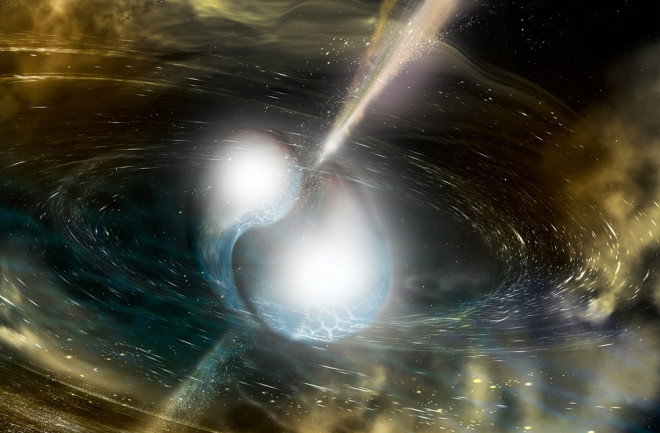
The dead cores of two stars collided 130 million years ago in a galaxy somewhat far away.
The collision was so extreme that it caused a wrinkle in space-time — a gravitational wave. That gravitational wave and the light from the stellar explosion traveled together across the cosmos. They arrived at Earth simultaneously at 6:41 a.m. Eastern on August 17.
The event prompted worldwide headlines as the dawn of “multimessenger astronomy.” Astronomers had waited a generation for this moment. But it was also the first-ever direct confirmation that gravity travels at the speed of light.
The Speed of Gravity
We all know light obeys a speed limit — roughly 186,000 miles per second. Nothing travels faster. But why should gravity travel at the same speed?
That question requires a quick dive into Albert Einstein’s general relativity, or theory of gravity — the same theory that predicted gravitational waves a century ago.
Einstein overthrew Isaac Newton’s idea of “absolute time.” Newton thought time marched onward everywhere at an identical pace — regardless of how we mortals perceived it. It was unflinching. By that line of thinking, one second on Earth is one second near a black hole (which he didn’t know existed).
Newton also thought gravity acted instantaneously. Distance didn’t matter.
It’s All Relative
But then Einstein showed that time is relative. It changes with speed and in the presence of gravity. One of the ramifications of that is that you can’t have simultaneous actions at a distance . So information of any kind has a finite speed, whether it’s a photon — the light-carrying particle — or a graviton, which carries the force of gravity.
“In relativity, there is a ‘speed of information’ — the maximum speed that you can send information from one point to another,” says University of Wisconsin-Milwaukee physicist Jolien Creighton, an expert on general relativity and member of the LIGO team that first spotted gravitational waves.
Creighton explains that in electromagnetism, when you shake an electron, it creates a change in the electric field that spreads out at the speed of light. Gravity works the same way. Shake a mass and the change in the gravitational field — the gravitational wave — propagates at that same speed.
“So the fact that the speed of gravitational waves is equal to the speed of electromagnetic waves is simply because they both travel at the speed of information,” Creighton says.
There’s an easy way to picture this, too. Imagine the sun vanished right now. Earth wouldn’t just drift into space instantly. After eight minutes, Earth would go dark and simultaneously push off in a straight line.
Already a subscriber?
Register or Log In

Keep reading for as low as $1.99!
Sign up for our weekly science updates.
Save up to 40% off the cover price when you subscribe to Discover magazine.

What Is a Gravitational Wave?
A gravitational wave is an invisible (yet incredibly fast) ripple in space.
We’ve known about gravitational waves for a long time. More than 100 years ago, a great scientist named Albert Einstein came up with many ideas about gravity and space.

Albert Einstein, official 1921 Nobel Prize in Physics photograph.
Einstein predicted that something special happens when two bodies—such as planets or stars—orbit each other. He believed that this kind of movement could cause ripples in space. These ripples would spread out like the ripples in a pond when a stone is tossed in. Scientists call these ripples of space gravitational waves .
Gravitational waves are invisible. However, they are incredibly fast. They travel at the speed of light (186,000 miles per second). Gravitational waves squeeze and stretch anything in their path as they pass by.

Illustration of how mass bends space. Credit: NASA
What causes gravitational waves?
- when a star explodes asymmetrically (called a supernova )
- when two big stars orbit each other
- when two black holes orbit each other and merge
An artist’s animation of gravitational waves created by the merger of two black holes. Credit: LIGO/T. Pyle
But these types of objects that create gravitational waves are far away. And sometimes, these events only cause small, weak gravitational waves. The waves are then very weak by the time they reach Earth. This makes gravitational waves hard to detect.
How do we know that gravitational waves exist?
In 2015, scientists detected gravitational waves for the very first time. They used a very sensitive instrument called LIGO (Laser Interferometer Gravitational-Wave Observatory). These first gravitational waves happened when two black holes crashed into one another. The collision happened 1.3 billion years ago. But, the ripples didn’t make it to Earth until 2015!

LIGO is made up of two observatories: one in Louisiana and one in Washington (above). Each observatory has two long “arms” that are each more than 2 miles (4 kilometers) long. Credit: Caltech/MIT/LIGO Lab
Einstein was right!
The first detection of gravitational waves was a very important event in science. Before this, just about everything we knew about the universe came from studying waves of light. Now we have a new way to learn about the universe—by studying waves of gravity.
Gravitational waves will help us learn many new things about our universe. We may also learn more about gravity itself!
How are gravitational waves detected?
When a gravitational wave passes by Earth, it squeezes and stretches space. LIGO can detect this squeezing and stretching. Each LIGO observatory has two “arms” that are each more than 2 miles (4 kilometers) long. A passing gravitational wave causes the length of the arms to change slightly. The observatory uses lasers, mirrors, and extremely sensitive instruments to detect these tiny changes.
Watch the animation below to see how this works!
Related Resources for Educators
Modeling Gravitational Waves Dropping In With Gravitational Waves
More about space!

What is a black hole?

What is the Big Bang?

What is a galaxy?
If you liked this, you may like:
We have completed maintenance on Astronomy.com and action may be required on your account. Learn More

- Login/Register
- Solar System
- Exotic Objects
- Upcoming Events
- Deep-Sky Objects
- Observing Basics
- Telescopes and Equipment
- Astrophotography
- Space Exploration
- Human Spaceflight
- Robotic Spaceflight
- The Magazine
Why do physicists think gravity travels at the speed of light?
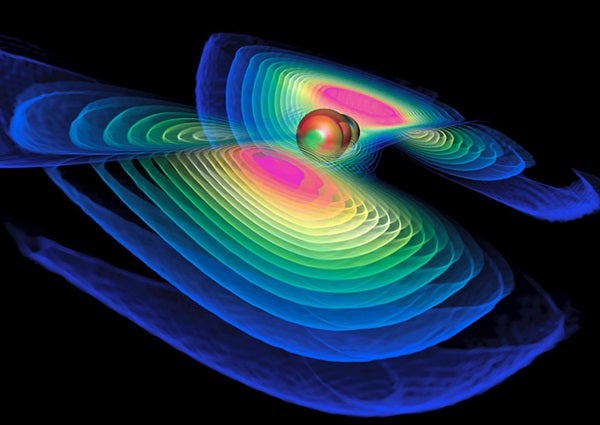
However, Einstein’s special relativity introduced the idea of a speed limit for the movement of all fields or information — the speed of light. Einstein constructed his general theory of relativity on the foundation of his earlier and more restricted special relativity, so light-speed remains the universe’s ultimate speed limit.
And indeed, when physicists solve Einstein’s equations, wherever small deviations appear in space-time (the fabric of space in relativity), the gravitational field at a given place and time does not change instantly, but appears “retarded.” That is, changes in the gravity field depend on the source’s earlier behavior — a time delay given by distance from the source divided by the speed of light. These solutions also reveal wavelike ripples that move through space-time precisely at the speed of light. These are gravitational waves.
So, general relativity predicts gravitational interaction and gravitational waves move with the same speed as light. On the other hand, alternative theories of gravity predict, via one mechanism or other, that the speeds could be different. This is why measuring the speed of gravity is an important test of Einstein’s theory.
So far, there is no experimental evidence one way or the other on the speed of gravity. In 2002, one team of experimenters measured the effect of Jupiter’s gravity field on light from a distant quasar as the planet moved in its orbit across the field of view. The group argued that, because of Jupiter’s motion, the deflection experienced by the light rays would be sensitive to the speed at which Jupiter’s gravity field propagated through space. They claimed to have shown the speed of gravity was within about 20 percent that of light.
But other scientists showed decisively that, to the experiment’s level of precision, the effect being measured did not depend on gravity’s speed, but instead depended only on the speed of light. The consensus of scientific opinion is that while the experiment was interesting, it provided no information about how fast gravity moves.
Such a measurement likely will have to wait until we’ve detected gravitational waves directly. A worldwide array of gravitational-wave observatories using laser interferometry now is operational, and there is a reasonable chance, once suitable upgrades are in place, that the array will detect gravity waves successfully before the decade ends.
When this happens, extremely precise measurements may be possible. These advanced detectors will be able to “see” cataclysmic events, such as a supernova or the merger of two neutron stars, at a distance as great as 500 million light-years. By comparing arrival times of the bursts of electromagnetic and gravitational waves with a precision of a few seconds, we could check for any difference in speed to the level of a few parts in 10 17 . This would be a stunning check of a key prediction of general relativity. — CLIFFORD WILL, WASHINGTON UNIVERSITY, ST. LOUIS
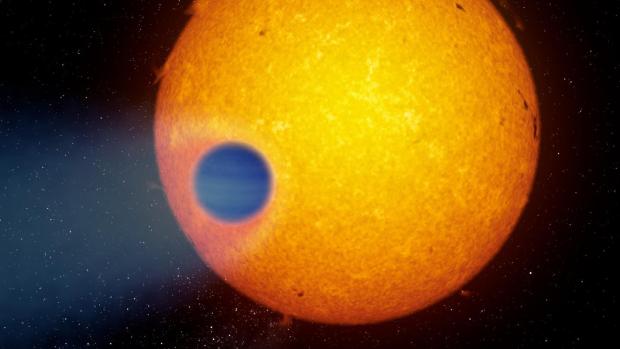
WASP-69b — and its weird tail — help us understand the cosmos
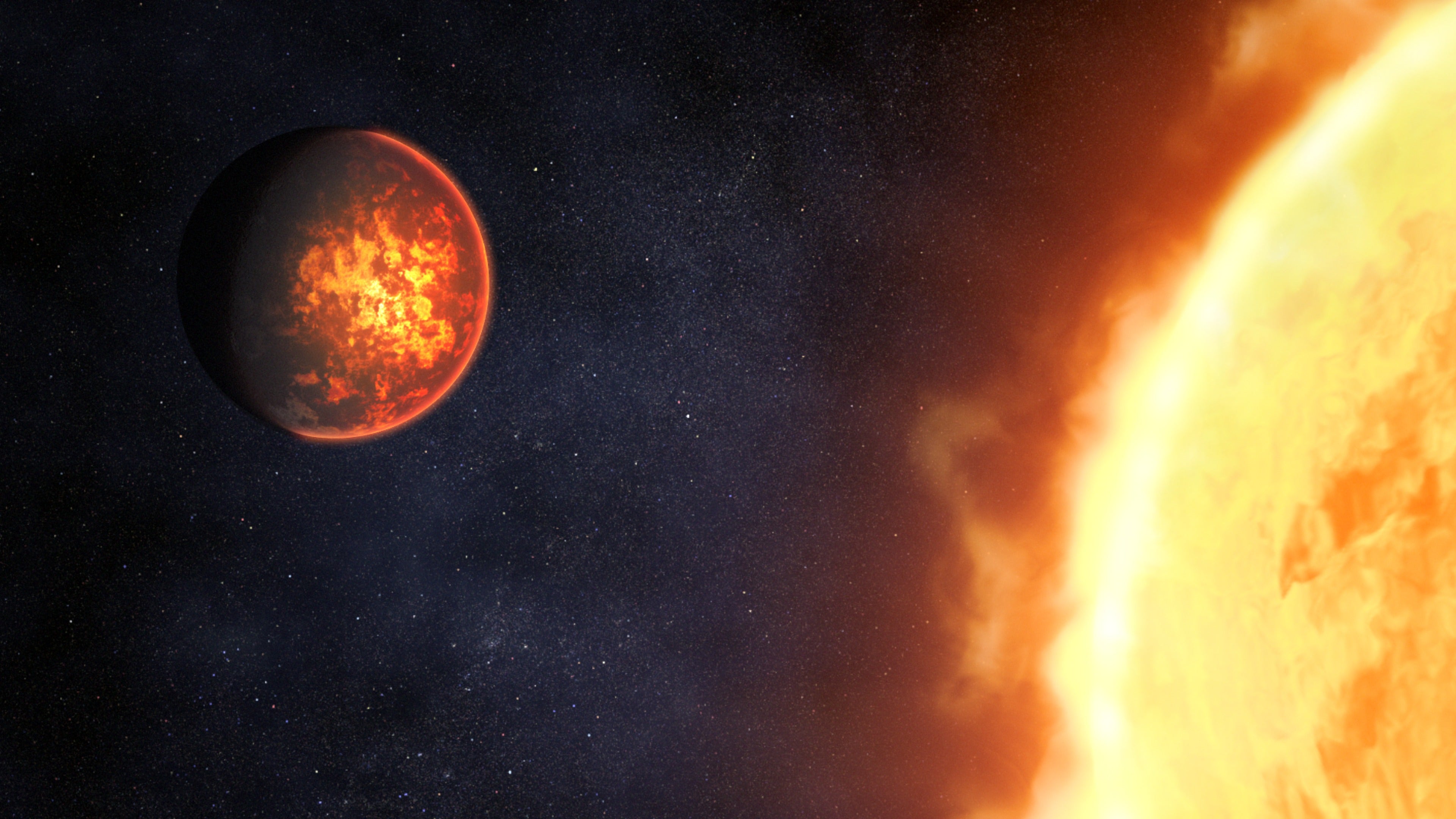
At last! JWST finds signs of a thick atmosphere around a rocky exoplanet
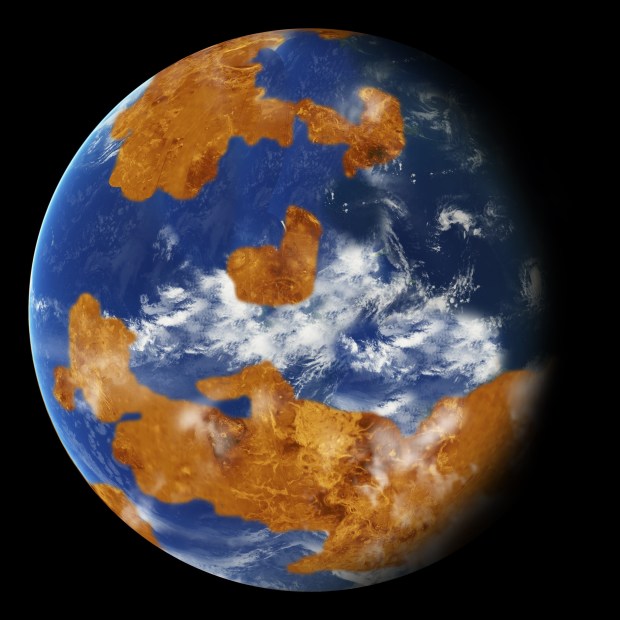
What happened to all the water on Venus?

2024 Full Moon calendar: Dates, times, types, and names
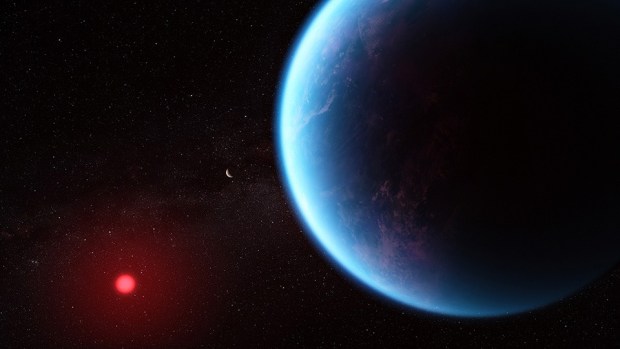
Possible hints of life found on exoplanet K2-18b – how excited should we be?
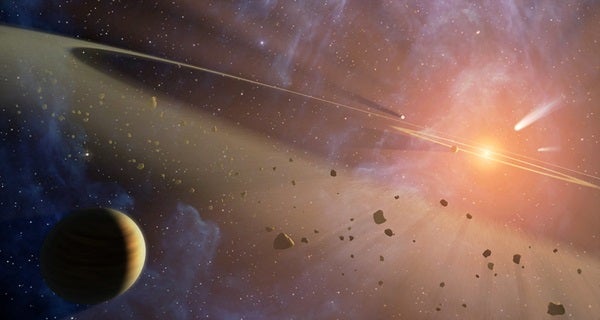
What happens if we detect alien life?
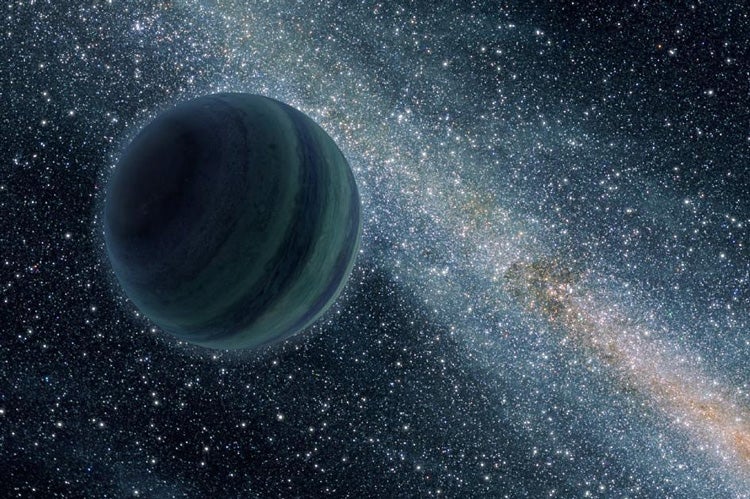
Does Planet Nine exist? The new evidence says yes.

How Markarian 205 nearly broke the universe: This Week in Astronomy with Dave Eicher
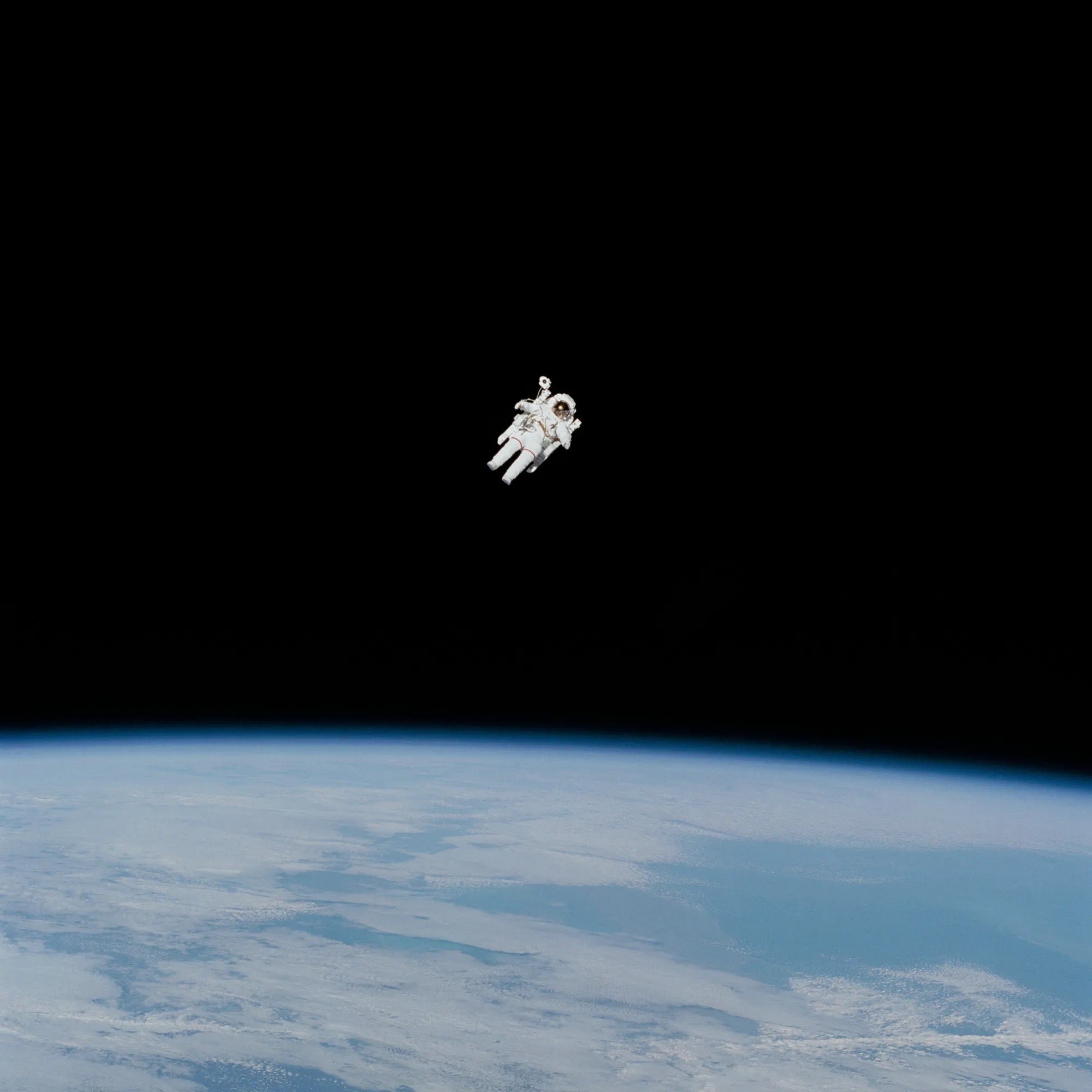
Astronauts have a surprising ability to gauge distances in space

Spiral Dance of Black Holes This illustration shows the merger of two black holes and the gravitational waves that ripple outward as the black holes spiral toward each other. The black holes—which represent those detected by LIGO on Dec. 26, 2015—were 14 and 8 times the mass of the sun, until they merged, forming a single black hole 21 times the mass of the sun. In reality, the area near the black holes would appear highly warped, and the gravitational waves would be difficult to see directly. Image credit: LIGO/T. Pyle
What are Gravitational Waves?

Two-dimensional illustration of how mass in the Universe distorts space-time. (Credit: NASA)
Gravitational waves are 'ripples' in space-time caused by some of the most violent and energetic processes in the Universe. Albert Einstein predicted the existence of gravitational waves in 1916 in his general theory of relativity. Einstein's mathematics showed that massive accelerating objects (things like neutron stars or black holes orbiting each other) would disrupt space-time in such a way that 'waves' of undulating space-time would propagate in all directions away from the source. These cosmic ripples would travel at the speed of light, carrying with them information about their origins, as well as clues to the nature of gravity itself.
The strongest gravitational waves are produced by cataclysmic events such as colliding black holes, supernovae (massive stars exploding at the end of their lifetimes), and colliding neutron stars. Other gravitational waves are predicted to be caused by the rotation of neutron stars that are not perfect spheres, and possibly even the remnants of gravitational radiation created by the Big Bang.
The animation below illustrates how gravitational waves are emitted by two neutron stars as they orbit each other and then coalesce (credit: NASA/Goddard Space Flight Center). Note that gravitational waves themselves are invisible. They are made visible here to illustrate their propagation away from the source.
Though Einstein predicted the existence of gravitational waves in 1916, the first proof of their existence didn't arrive until 1974. In that year, two astronomers, Russell Hulse and Joseph Taylor, using the Arecibo Radio Observatory in Puerto Rico discovered a binary pulsar 21000 light years from Earth. This was exactly the type of system that general relativity predicted should radiate gravitational waves. Knowing that the system could be studied to test Einstein's prediction, Taylor and two colleagues (Joel Weisberg and Lee Fowler) began tracking the radio emissions from the stars to measure how their orbital period changed over time. After just four years, they first reported seeing a change in the period that verified that the stars were getting closer to each other at the rate predicted by general relativity (GR) if they were radiating gravitational waves (the rate predicted by GR agreed with the observed rate to within one half of one percent). In 1993, Hulse and Taylor would receive the Nobel Prize in Physics " for the discovery of a new type of pulsar, a discovery that has opened up new possibilities for the study of gravitation ".
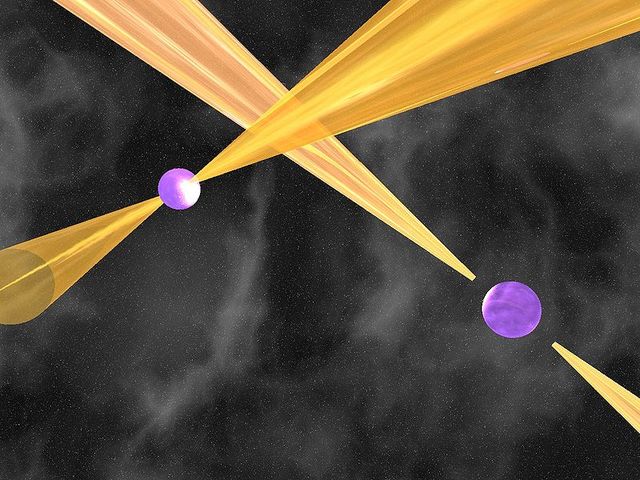
Artist's Impression of a Binary Pulsar. (Credit: Michael Kramer, Jodrell Bank, University of Manchester)
Since then, many astronomers have studied pulsar radio-emissions (pulsars are neutron stars that emit beams of radio waves) and found similar effects, further confirming the existence of gravitational waves. But these confirmations had always come indirectly, requiring that one infer the existence of gravitational waves.
All of this changed on September 14, 2015 when LIGO physically sensed the undulations in spacetime caused by gravitational waves generated by two colliding black holes 1.3 billion light-years away. LIGO's first detection will go down in history as one of humanity's greatest scientific achievements.
While the processes that generate measurable gravitational waves are extremely violent, by the time the waves reach Earth they are thousands of billions of times smaller (due to the 'stiffness' of space), and much smaller when they reach us, much as sounds are weaker when you move further from the source. In fact, by the time gravitational waves from LIGO's first detection reached us, the amount of space-time wobbling they generated was a 10,000 times smaller than the nucleus of an atom ! LIGO was designed to make such inconceivable, exquisitely small measurements. To learn how LIGO achieves this seemingly impossible task, visit LIGO's Interferometer .
Contact LIGO Caltech
LIGO Laboratory MC 100-36 California Institute of Technology Pasadena, CA 91125
Information: (626) 395-2129
Anti-Harassment Policy | Image Use Policy | Privacy Policy

The LIGO Laboratory is supported by the National Science Foundation and operated jointly by Caltech and MIT. Any opinions, findings and conclusions or recommendations expressed in this material do not necessarily reflect the views of the National Science Foundation.

LIGO Laboratory is member of the LIGO Scientific Collaboration. We observe and publish science with the Virgo Collaboration
Website designed by IPAC Communications & Education Team

Suggested Searches
- Climate Change
- Expedition 64
- Mars perseverance
- SpaceX Crew-2
- International Space Station
- View All Topics A-Z
Humans in Space
Earth & climate, the solar system, the universe, aeronautics, learning resources, news & events.

How NASA’s Roman Mission Will Hunt for Primordial Black Holes

International SWOT Mission Can Improve Flood Prediction

New NASA Black Hole Visualization Takes Viewers Beyond the Brink
- Search All NASA Missions
- A to Z List of Missions
- Upcoming Launches and Landings
- Spaceships and Rockets
- Communicating with Missions
- James Webb Space Telescope
- Hubble Space Telescope
- Why Go to Space
- Astronauts Home
- Commercial Space
- Destinations
- Living in Space
- Explore Earth Science
- Earth, Our Planet
- Earth Science in Action
- Earth Multimedia
- Earth Science Researchers
- Pluto & Dwarf Planets
- Asteroids, Comets & Meteors
- The Kuiper Belt
- The Oort Cloud
- Skywatching
- The Search for Life in the Universe
- Black Holes
- The Big Bang
- Dark Energy & Dark Matter
- Earth Science
- Planetary Science
- Astrophysics & Space Science
- The Sun & Heliophysics
- Biological & Physical Sciences
- Lunar Science
- Citizen Science
- Astromaterials
- Aeronautics Research
- Human Space Travel Research
- Science in the Air
- NASA Aircraft
- Flight Innovation
- Supersonic Flight
- Air Traffic Solutions
- Green Aviation Tech
- Drones & You
- Technology Transfer & Spinoffs
- Space Travel Technology
- Technology Living in Space
- Manufacturing and Materials
- Science Instruments
- For Kids and Students
- For Educators
- For Colleges and Universities
- For Professionals
- Science for Everyone
- Requests for Exhibits, Artifacts, or Speakers
- STEM Engagement at NASA
- NASA's Impacts
- Centers and Facilities
- Directorates
- Organizations
- People of NASA
- Internships
- Our History
- Doing Business with NASA
- Get Involved
- Aeronáutica
- Ciencias Terrestres
- Sistema Solar
- All NASA News
- Video Series on NASA+
- Newsletters
- Social Media
- Media Resources
- Upcoming Launches & Landings
- Virtual Events
- Sounds and Ringtones
- Interactives
- STEM Multimedia

NASA’s Webb Hints at Possible Atmosphere Surrounding Rocky Exoplanet

NASA, JAXA XRISM Spots Iron Fingerprints in Nearby Active Galaxy
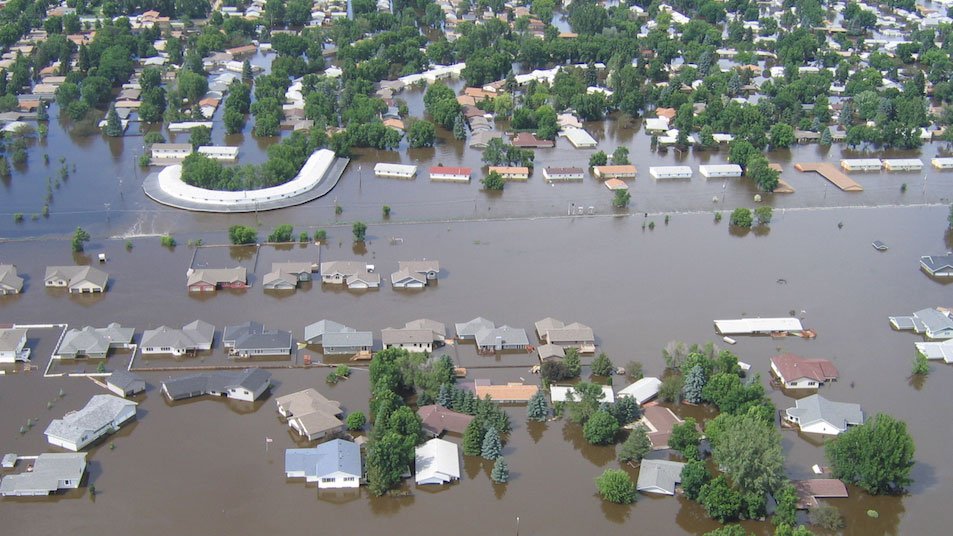
International SWOT Mission Can Improve Flood Prediction

NASA Mission Strengthens 40-Year Friendship

NASA Selects Commercial Service Studies to Enable Mars Robotic Science

NASA’s Commercial Partners Deliver Cargo, Crew for Station Science

NASA Is Helping Protect Tigers, Jaguars, and Elephants. Here’s How.

C.26 Rapid Mission Design Studies for Mars Sample Return Correction and Other Documents Posted

NASA Selects Students for Europa Clipper Intern Program

Orbits and Kepler’s Laws

NASA’s TESS Returns to Science Operations

ARMD Solicitations

NASA’s Commitment to Safety Starts with its Culture

NASA Uses Small Engine to Enhance Sustainable Jet Research

Tech Today: NASA’s Ion Thruster Knowhow Keeps Satellites Flying

Big Science Drives Wallops’ Upgrades for NASA Suborbital Missions

NASA Challenge Gives Artemis Generation Coders a Chance to Shine

NASA Community College Aerospace Scholars

Ken Carpenter: Ensuring Top-Tier Science from Moon to Stars

White Sands Propulsion Team Tests 3D-Printed Orion Engine Component

A Different Perspective – Remembering James Dean, Founder of the NASA Art Program

Diez maneras en que los estudiantes pueden prepararse para ser astronautas

Astronauta de la NASA Marcos Berríos

Resultados científicos revolucionarios en la estación espacial de 2023
The invisible world of gravitational waves.
Information about the universe is all around us. But there’s more than meets the eye! Gravitational waves are the invisible ripples in spacetime caused by supermassive interstellar activity. Join astrophysicists Ira Thorpe and Judy Racusin on an exploration of how NASA studies these unseen bends in time and space.
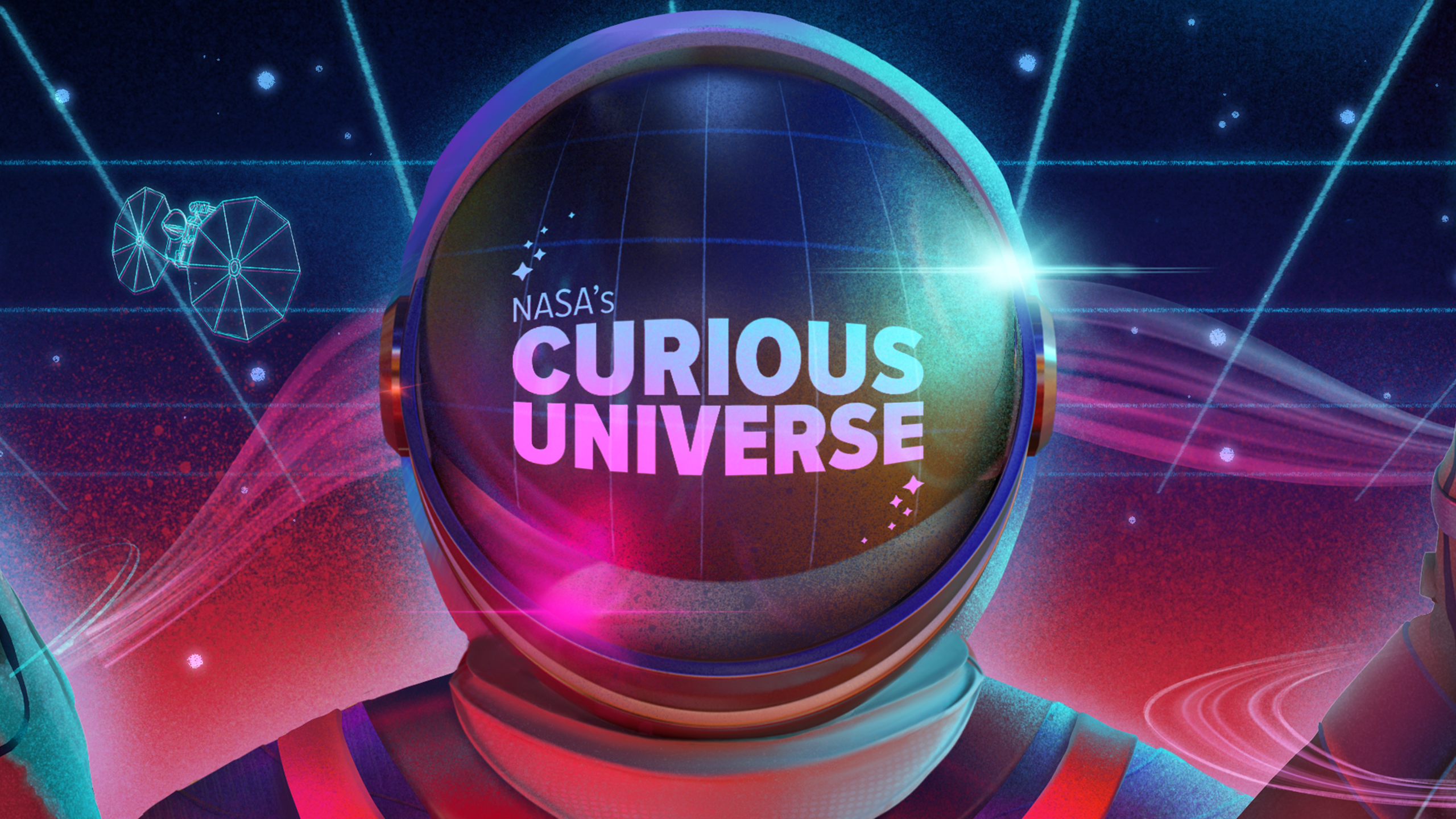
Listen to the Podcast

Introducing NASA’s Curious Universe:
Our universe is a wild and wonderful place. Join NASA astronauts, scientists and engineers on a new adventure each episode — all you need is your curiosity. Explore the lifesaving systems of space suits, break through the sound barrier, and search for life among the stars. First-time space explorers welcome.
Episode Description :
Information about the universe is all around us. But there’s more than meets the eye! Gravitational waves are the invisible ripples in spacetime caused by supermassive interstellar activity. Join astrophysicists Ira Thorpe and Judy Racusin on an exploration of how NASA studies these unseen bends in time and space.
The easiest way I can explain a gravitational wave…
[Song: Gravitational Waves Instrumental by Green]
…Is, many people have seen these pictures of the idea that space time is kind of like this rubber sheet. And you have this idea that massive objects like stars and planets, or especially black holes, can deform that sheet of space time.
And a gravitational wave is a ripple in that sheet. You can imagine if you bounced up and down a star, you can get a ripple that travels across that medium. That ripple travels with the speed of light, it carries energy, it carries momentum. And it can carry information about the objects that produced it. We want to build a gravitational wave detector so that we can read those waves, detect those waves, use them to understand the objects that produced them.
[Theme Song: Curiosity Theme by SYSTEM Sounds]
HOST PADI BOYD: This is NASA’s Curious Universe. Our universe is a wild and wonderful place. I’m your host Padi Boyd and in this podcast, NASA is your tour guide.
HOST PADI BOYD: We have so many ways of understanding our universe. Telescopes on Earth and in space bring us incredible pictures, provide information about the composition of faraway planets and galaxies, and even clue us in to information the human eye can’t see.
HOST PADI BOYD: But the electromagnetic light we capture with a telescope isn’t the only information the universe is providing us! There are so many ways to “sense,” or understand, the universe, including through a relatively new discovery called gravitational waves.
[Song: Internals Underscore by Coon and Goebel]
HOST PADI BOYD: Gravitational waves are traveling ripples in time and space. The ones we can detect here on Earth are caused by the gravity of really, really big objects ! Things like neutron stars, black holes, and orbiting binary stars send out far-reaching waves of gravity, affecting how space and time behave around them. By using huge and highly sensitive detectors, we can sense some of these waves and learn more about the objects sending them out.
HOST PADI BOYD: You can’t see a gravitational wave, and the ones that reach us aren’t strong enough for us to feel or experience on our own. But we are at the very beginning of learning what they can teach us about our origins and the universe around us. So today we’re going to join two astrophysicists on their journey into the invisible, time-warping world of gravitational waves .
My name is Dr. Ira Thorpe and I study gravitational waves.
[Song: Breaking Underscore by Coon and Geobel]
With the exception of the planets that we can travel to, maybe some cosmic rays, and interstellar meteors and such that might have come to us, all the other information we can get about most of the universe is coming from light which is traveling to us.
Gravitational waves gives us a chance to break out of the electromagnetic spectrum altogether, and have a different what we call messenger, a different form of information, and it gives us different kinds of information. Some of the information that’s really difficult to get electromagnetically is easy to get through gravitational waves.
HOST PADI BOYD: The way an object interacts with space and time around it can tell us so much about its properties! But understanding these changes, which we can’t see or feel, can be tricky. So we create different ways to represent and conceptualize this important piece of information.
HOST PADI BOYD: You might have seen computer generated images of gravitational waves. Imagine a big sheet pulled really tightly. If you put a heavy object, like a bowling ball, in the middle of that sheet, it would dip and curve, causing effects not only where the ball has landed but out to each edge. And if you bounced the ball…
[[Bouncing ball sound]]
HOST PADI BOYD:…The ripples would be really strong near the middle and get weaker and weaker as you move toward the edge of the sheet.
HOST PADI BOYD: That’s what happens when any object interacts with what we call “spacetime” — the dimensions we experience of time and physical, “3-d” space. If something with enough mass moves, or explodes, its gravity warps the “sheet” of spacetime around it and causes a ripple effect.
HOST PADI BOYD: The objects we’re talking about have to be really massive in order for our instruments to sense the difference it makes in how we experience time or space… really, massive!
[Song: Facts Underscore by Coon and Goebel]
HOST PADI BOYD: And even though we can’t feel it, we are awash in these waves from different space objects all the time.
The Earth is constantly bathed in gravitational waves. You have to have an incredible amount of mass and energy moving at really high speeds in order to make an appreciable gravitational wave. In principle, something like the Earth going around the Sun makes gravitational waves, but they’re so weak, you wouldn’t ever notice them.
HOST PADI BOYD: We don’t notice these effects from the space objects around us, but that doesn’t mean all gravitational waves are weak. In fact, the strongest energy release scientists have ever discovered wasn’t in the form of a visually bright star, it was in gravitational waves.
It’s only when you get something like a black hole that you can produce these ripples. And once you do, they carry a lot of energy. The most energetic single events since the Big Bang are mergers of black holes, and all the energy comes out in gravitational waves. The amount of energy released per unit time at the very end of that burst is bigger than any high energy event that we ever see with our telescopes. Brighter than the supernova, brighter than a gamma ray burst, but none of that energy comes out as light. It’s all coming out as gravitational waves.
HOST PADI BOYD: Not only can these waves be really strong, they are always really fast, just like light. In fact, gravitational waves travel at the speed of light: 186,000 miles per second!
HOST PADI BOYD: If you want to study these fast-moving, space-rippling waves, you should probably aim your interest at cosmic objects whose gravity is really strong.
[Song: Spotter Underscore by Coon and Goebel]
Judy Racusin
I’m Dr. Judy Racusin. I’m an astrophysicist. I study gamma ray bursts, primarily, this is my specialty. These are the most energetic explosions in the universe. And I work on current and future missions that we use to study the highest energy form of light.
A gravitational wave is a ripple in spacetime itself that is caused by massive objects, doing something that has some asymmetry to it.
HOST PADI BOYD: Asymmetry means something that isn’t symmetrical, or isn’t perfectly balanced. A single spinning star isn’t likely to cause a big gravitational wave by itself. As soon as you add an orbiting companion, you get an asymmetry.
Maybe it’s a really dense star with a bump on it, or two black holes or two neutron stars that are in-spiraling towards each other.
HOST PADI BOYD: The study of gravitational waves is part of a field called “multi-messenger astronomy.” Scientists are interested in unlocking all the secrets of the cosmos that we can. For a long time, we just studied light from distant objects with our telescopes. But light is no longer the only “messenger” bringing us information from distant objects. We can now use other tools to sense the universe.
[Song: Pigments Underscore by Coon and Goebel]
We talk about gravitational waves sometimes instead of seeing it as hearing it. It’s not really, you know, sound, but it is something that has frequencies like sound has frequencies.
Different masses of objects cause those different sizes of those ripples in spacetime. Supermassive black holes in the centers of galaxies that in-spiral, those cause longer frequency of gravitational waves. Smaller objects, like stellar mass black holes or neutron stars have the shorter frequency gravitational waves.
HOST PADI BOYD: Keep in mind, those “smaller” stellar mass black holes are still about 10 times more massive than our sun. And the supermassive black holes Judy mentioned can be millions or billions of times more massive than the sun. These are really, really, dense objects we’re talking about here.
HOST PADI BOYD: Studying gravitational waves is crucial to building upon our understanding of the universe. This newly discovered type of information scientists get from these invisible waves can help us gather a fuller, more detailed picture of our place in space.
[Song: Circles of Life Underscore by James Carlin Baker]
The universe is incredibly rich in terms of the amount of light and radiation and such that it’s bringing to us. And yet, there’s this entire other hidden part of the universe that has been with us the entire time we’ve been on the planet.
To give you an example, you can show a person a picture of a jungle. And you say, ‘Well, what do you see?’ and you see all kinds of plants and such, but it’s basically all green.
And then if you play audio that someone’s recorded in a rainforest. Now you’re like, ‘Oh, I, you know, I hear these insects, I hear these birds, I hear this jaguar.’
[[Jungle sounds: insects buzzing, birds singing, jaguar roars]]
Without your hearing, no matter how good your sight is, you’re gonna miss those things. Of course without your sight, you’re not gonna see all the trees and everything else.
And you put the two things together, and you get this complete understanding of what’s going on, then maybe add some smells and such as well.
That’s what we’re trying to do is add another sense to our toolkit for understanding the universe.
[[Jungle sounds end]]
HOST PADI BOYD: Observing gravitational waves is a relatively new technique in the world of astronomy. But physicists have been theorizing about gravity and spacetime before they even knew about the super massive objects like black holes. In fact, I’m “ relatively ” sure you’ll recognize the first person to suggest the existence of ripples in spacetime.
[Song: Report Underscore by Coon and Goebel]
The origin of gravitational waves from a theoretical understanding goes back to Einstein, about 100 years ago.
He famously, in 1915, wrote down the theory of general relativity. It wasn’t until decades later, when astronomers started to understand that things like black holes might exist, when people started to develop technologies like lasers, and computer chips, that people started to get serious about, well maybe we could actually detect them.
That was back in the 60s, and then especially into the 70s, that people started working in earnest to build gravitational wave detectors.
And it wasn’t until 2015, that we finally actually detected the first gravitational wave directly with the LIGO instrument.
HOST PADI BOYD: The LIGO instrument is run by the National Science Foundation. Its name, LIGO, stands for “Laser Interferometer Gravitational Wave Observatory.” The instrument itself is a huge L-shaped structure. Each of the arms is nearly four kilometers, or two and a half miles, long!
HOST PADI BOYD: This incredible machine works to detect super minute changes in space and time. It uses lasers and mirrors to determine if space around it is stretching or contracting in tiny increments because of super massive objects extremely far away.
HOST PADI BOYD: Not only does the LIGO instrument have two arms, but there are two facilities, each with their own instrument, working together for even more sensitive detection of changes across a much larger area of Earth’s surface. One is in Livingston, Louisiana, and the other in Hanford, Washington.
HOST PADI BOYD: The instruments work kind of like an antenna. You can collect different frequencies based on how big or small the antenna itself is.
HOST PADI BOYD: Einstein’s theory and the new discoveries with the LIGO instruments not only solidified gravitational waves as a new way to sense the universe, it allowed for a new understanding of how our dimensions work together. A new understanding of spacetime!
When we talk about the term, spacetime, and this is when I talk about it, the essential difference that came out of Einstein’s work is that prior to that, we’d think of spacetime as an empty framework in which physics happens. In which the universe does stuff. It’s like the box in a theater where the actors are running around. It just sort of sits there. And it’s the place where the action happens.
When we talk about dynamic spacetime, which is how we understand gravity to work, the spacetime is involved in the physics, it’s a fundamental component of it as well. That, to me, is what we mean by spacetime, It’s not a rigid framework where the action happens, it’s part of the action.
Dimensions of space, you know, three dimensions of space plus the time dimension. And as Einstein showed in his work, those things are related to one another in kind of interesting ways.
HOST PADI BOYD: There are whole books written about Einstein’s theory of relativity, but to put it simply it showed that gravity is not just a force but a field that can distort time and space.
HOST PADI BOYD: This is pretty advanced physics done by astrophysicists who have done lots of homework. But Ira, Judy and their colleagues are just like us. They put their shoes on one foot at a time, in precisely the same amount of dimensions as you and me.
I think the average NASA scientist works with the same number of dimensions as everybody else, we are four dimensional beings, right? Meaning that three of space and time, that’s what we work with.
[Song: Ants Instrumental by Taylor Welsh]
HOST PADI BOYD: So what would it feel like to experience a strong gravitational wave first-hand? Well it turns out the name gives us a bit of a clue.
Gravitational waves manifest themselves the same way that other gravitational effects do, which is through tides. You can think of them as producing a tidal effect. And this is what they do to our detectors, our detectors just have to be very sensitive to pick it up.
So what a tidal effect means is you basically have a different gravitational pull on different parts of the same object. A tidal effect is your head being pulled a little harder than your feet and so it’s sort of an effective stretch. What happens when a gravitational wave passes by is on one direction, you get a stretch, and on the opposite direction, or the perpendicular direction, you get a squish, and then those oscillate back and forth.
If you were in an environment where there was a strong gravitational wave, you are going to have bigger problems because you are next to black holes or neutron stars with intense radiation, not to mention the explosive energy that will fry you immediately.
There’s no chance of this happening anywhere near us. Even if one happened in our galaxy, it’d be fascinating, but it’s unlikely.
You would experience kind of the effects that you would I guess have around a black hole. Space would be stretching and time would be stretching and contracting. It’s just strong gravity that is pulling you apart and squishing you back together.
HOST PADI BOYD: In order to learn more about these far off but fascinating phenomena, Ira is working on a future mission called LISA, being led by the European Space Agency. LISA is a gravitational wave detector that won’t reside here on Earth but in the vast expanse beyond our atmosphere instead!
So we want to do gravitational wave detection from space, but not just because going to space is cool, right? Going to space is hard.
[Song: River Run Underscore by Elias Ramani]
It’s much easier to have your detector on the ground, and to be able to go diagnose it and adjust it and improve it.
The reason we want to go to space is because we can make the detector much, much bigger. And by making it much, much bigger, we can actually access different kinds of gravitational waves, different wavelengths.
HOST PADI BOYD: Like LIGO, LISA will have arms that work together to sense the environment around them. But instead of physical arms rooted on the ground, LISA will consist of three orbiting space craft connected by long, LONG lasers!
There’s three individual spacecraft. They connect to one another with these laser links. So they shoot lasers back and forth between the three satellites in this triangle. The arm lengths of this particular mission, the Laser Interferometer Space Antenna, or LISA, it’s two and a half million kilometers between each spacecraft.
HOST PADI BOYD: Just as a reminder, LIGO is on the ground, and its arms are 4 kilometers, or around two and a half miles long. LISA’s arms will be out in space, two and a half million kilometers — or over 1.5 million miles — long.
And that works out, and this is just coincidence, I promise, that if you were to draw that around the Sun, the Sun fits just perfectly right inside it. So that’s how big this instrument will be, it’ll be something the size that the sun could literally fit inside.
HOST PADI BOYD: This is a really fun area of astrophysics to think about — super massive objects messing with the normal routine of space and time. And there are lots of plans, like LISA mission, to expand our understanding of gravitational waves. But like a lot of things here at NASA, we have to be ready and wait for the universe to send information our way. We can test all kinds of things on Earth in laboratories, but we can’t test this.
We don’t possess the ability to harness that much energy, to make gravitational waves in the lab.
The first source detected by LIGO was a pair of black holes, each weighing roughly 30 times the mass of our Sun, and they’re orbiting each other many times a second, hundreds of times a second. So if you just sort of picture that in your mind, there’s something that weighs 30 times the mass of the Sun, and it’s going around another one of those things, as fast as your kitchen blender, then you understand why we can’t build that on the Earth.
People have proposed maybe some advanced alien civilization that could produce gravitational waves, and it would be a way for them to announce their presence. I’m a little skeptical about how that would actually be but it’s an interesting idea. Maybe we will see unexpected signals. In fact, I hope we see unexpected signals, with the ground-based and the space-based detectors that we have built and are working to build. I think most of them will teach us about our universe from an astrophysical, cosmological kind of standpoint. But maybe we’ll learn something really unprecedented and unexpected. That’s another reason why we do the work.
HOST PADI BOYD: Even if we never hear a gravitational wave beacon from another civilization, it’s still important for us to follow these theories and find out more about how things work.
[Song: Cosmological Underscore by Elias Ramani]
HOST PADI BOYD: Gravitational waves can tell us so much about the universe — it can show how different objects interact, explain strange phenomena, and help us better understand how our universe is expanding.
HOST PADI BOYD: But more than that, it opens the door for a deeper understanding of physics — and important truths about how our universe behaves.
Like anything in astrophysics, we want to know how the universe works. How stars and galaxies and planets evolve over time, I mean, it tells us something fundamental about where we came from, about the history of our galaxy, you know, our solar system. It’s also just learning about the fundamental physics, like how does physics work? And gravitational waves are a unique and different way to view the universe. This field is just at its beginning. And I think there’s a lot of exciting science that’s going to happen in the next few years.
HOST PADI BOYD: This area of study is ripe with new knowledge and, as an astrophysicist myself, I cannot wait to see what we discover next. We just have to be ready and keep our eyes and ears — and gravitational wave detectors — open to what the universe has in store.
Any observatory you go into you propose certain science you’re going to do but there’s always things you learn that you never expected. You won’t see those things if you don’t look.
[Song: Curiosity Outro by SYSTEM Sounds]
HOST PADI BOYD: This is NASA’s Curious Universe. This episode was written and produced by Christina Dana. Our executive producer is Katie Konans. The Curious Universe team includes Maddie Arnold and Micheala Sosby, with support from Christian Elliott.
HOST PADI BOYD: Our theme song was composed by Matt Russo and Andrew Santaguida of SYSTEM Sounds.
HOST PADI BOYD: Special thanks to Amber Straughn, Barb Mattson, and Claire Andreoli.
HOST PADI BOYD: If you liked this episode, please let us know by leaving us a review, tweeting about the show and tagging @NASA, or sharing NASA’s Curious Universe with a friend. Still curious about NASA? You can send us questions about this episode or a previous one, and we’ll try to track down the answers. You can email a voice recording or send a written note to [email protected] . Go to NASA.gov/curiousuniverse for more information.
Producer Christina Dana
Does anything we’ve talked about today have anything to do with time travel?
Time travel is a fun construct for science fiction. We do travel in time, we travel forward. Um, whether or not you can go backwards is something in the realm of science fiction, or theorists who are well beyond what I do. Time can move faster in a dense gravitational field. Or if you’re accelerating. If you’re traveling close to the speed of light, like, the rules are all very different.
Gravitational Waves
The newest branch of astronomy doesn’t rely on light. Instead, it measures gravitational waves: tiny ripples in the structure of spacetime created by colliding black holes , neutron stars , or other powerful cosmic events. Gravitational wave astronomy allows us to probe a new part of the unseen universe, with its own challenges and knowledge we can’t get other ways.
Center for Astrophysics | Harvard & Smithsonian scientists study gravitational waves in several different ways:
Using visible light, X-ray, and radio telescopes to perform follow-up observations of gravitational wave events from LIGO. In particular, neutron star collisions produce a lot of light in addition to gravitational radiation. While the gravitational waves reveal details about the masses and shapes of the neutron stars, light tells us about the violent nuclear and chemical reactions, along with the material that is blown off during the explosion. Astronomers See Light Show Associated With Gravitational Waves
Working with the international LIGO collaboration to identify and characterize the astronomical systems involved in producing gravitational wave events. The data from gravitational waves are used to understand the nature of black holes, neutron stars, and even the evolution of the universe as a whole. Gravitational Waves Measure the Universe
- Identifying systems consisting of two white dwarfs locked in mutual orbit. LIGO isn’t sensitive to gravitational waves from these binaries, but they’ll be the most common source for the upcoming Laser Interferometer Space Antenna (LISA), a joint NASA-ESA space-based gravitational wave observatory. One of these binaries completes one orbit every 12.75 minutes, making it the “brightest” known gravitational wave source for LISA. Space-Warping White Dwarfs Produce Gravitational Waves
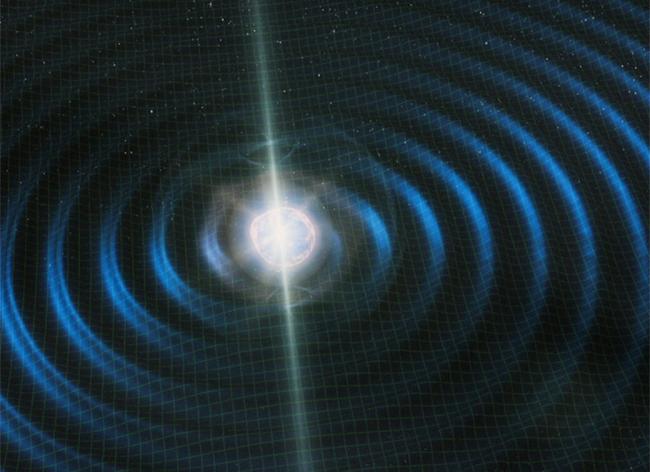
This artist's impression shows the final stage of the merger of two neutron stars and the gravitational waves produced by the collision. Astronomers identified such a merger in 2017 using gravitational wave detectors, as well as with optical and X-ray telescopes.

Astronomy Using Gravity
Gravitational waves, also known as gravitational radiation, were predicted by Albert Einstein as a consequence of his theory of general relativity. This theory describes gravity as distortions in the structure of spacetime created by matter and energy. Einstein realized those distortions would travel at the speed of light in the form of waves, much like light itself can be described as a wave.
However, gravity is so weak that even a high-energy gravitational wave barely nudges objects in its path. For that reason, our best hope is to detect gravitational waves from objects that produce very intense gravity because they pack a lot of mass into a very small space. That category includes the sources we’ve detected so far: colliding black holes and neutron stars.
In 2015, a century after Einstein published general relativity, researchers used the Laser Interferometer Gravitational Observatory (LIGO) to detect the collision between two black holes. Two years later, LIGO scientists identified a collision between two neutron stars, an event also observed using light.
Using both gravitational wave and light-based astronomy is known as “multimessenger astronomy”. This is an exciting development for researchers studying the structure of neutron stars, and understanding the creation of many chemical elements such as gold, which are produced in neutron star collisions.
- What happens to space time when cosmic objects collide?
- The Energetic Universe
- Einstein's Theory of Gravitation
- Stellar Astronomy
Related News
The giant magellan telescope’s final mirror fabrication begins, streamlining the search for black holes, tracing the origins of rare, cosmic explosions, cfa scientists awarded prestigious nasa hubble fellowships, the unfolding story of a kilonova told in x-rays, sensing the dynamic universe, telescopes and instruments, giant magellan telescope, magellan telescopes, mmt observatory.

How do gravitational waves work?

Paul M. Sutter is an astrophysicist at SUNY Stony Brook and the Flatiron Institute, host of " Ask a Spaceman " and " Space Radio ," and author of " How to Die in Space ." Sutter contributed this article to Space.com's Expert Voices: Op-Ed & Insights .
Gravity isn't just a force that keeps things glued together. Through our understanding of general relativity, we know that gravity can make gravitational waves, or ripples in the fabric of space-time.
But how do these gravitational waves work, exactly?
Shortly after formulating his general theory of relativity , Albert Einstein realized that gravity can make waves. However, he quickly doubted his own conclusions. The realization that gravitational waves exist came from a simplified form of general relativity, and Einstein didn't know if the waves were real or just an artifact of the simplification process.
Related : We could hunt gravitational waves on the moon if this wild idea takes off
The equations of general relativity are notoriously difficult to solve, so it's no surprise that even Einstein equivocated about this. It took several decades before physicists came to the firm conclusion that general relativity does support gravitational waves. In other words, they are indeed a real thing.
Pretty much anything in the universe doing anything at all makes gravitational waves. All it takes is a little wiggling, which gravitational waves have in common with pretty much any other wave. If you wiggle around in water, you make water waves. If your voice box wiggles around, it makes sound waves. If you wiggle an electron, you make electromagnetic waves. To make a gravitational wave, all you need to do is make mass accelerate.
Get the Space.com Newsletter
Breaking space news, the latest updates on rocket launches, skywatching events and more!
These waves travel outward from the source at the speed of light and are literal ripples in the force of gravity. When a gravitational wave passes through you, you get stretched and squeezed as if giant hands were playing with you like a piece of putty.
Did you feel that?
Even though pretty much everything in the universe is making gravitational waves all the time, you don't really notice them. Gravity is, by far, the weakest of the four fundamental forces of nature . Even if gravity were a billion billion billion times stronger than it is, it would still be orders of magnitude weaker than any of the other forces: the weak force , electromagnetism and the strong force . And gravitational waves are weaker still; they are tiny perturbations on top of the normal gravity.
This also means that the gravitational waves that you might make by, say, waving your arms around are almost entirely nonexistent. To make a serious dent in space-time, you need some serious mass and energy action — stuff like black hole collisions, neutron star smashups , supernovas, giant black holes that consume stars whole or even the chaotic forces unleashed in the earliest moments of the Big Bang .
If you were within about half a mile of two black holes merging , the gravitational waves emitted would be strong enough to tear you apart. But if you were hundreds of miles away, it wouldn't even make the hair on the back of your neck stand on end.
From our vantage point on Earth , millions or billions of light-years away from these cataclysmic events, the gravitational waves have an amplitude no bigger than the width of a proton.
Of course it was weird
The extreme weakness of gravitational waves is why it took nearly a quarter century of technological development to detect them. But in 2015, the Laser Interferometer Gravitational-Wave Observatory (LIGO) confirmed the first direct detection of gravitational waves . The source of that particular signal was two black holes merging 1.4 billion light-years away.
There's an upside to the weakness of gravitational waves: Because gravity is so weak, the gravitational waves barely interact with matter, thereby allowing them to propagate freely throughout the universe without scattering or being absorbed. It also means we can see things we normally couldn't.
If two black holes collide in the middle of space, how could we really see them? If they don't emit any form of electromagnetic radiation during the collision, the entire process is invisible to our telescopes. But those collisions release tremendous amounts of energy in the form of gravitational waves — usually more power than that produced by all of the stars in the universe combined.
Since that first confirmed detection in 2015, LIGO and Virgo — its sibling observatory in Italy — have confirmed over four dozen black hole collisions. We've gone from the occasional gravitational wave detection to a full-fledged branch of astronomy. These subtle vibrations have unlocked insight into the inner workings of the cosmos and newfound mysteries for the next generation of astronomers.
Learn more by listening to the episode "What's so groovy about gravitational waves? (Part 1)" on the "Ask a Spaceman" podcast, available on iTunes and askaspaceman.com . Ask your own question on Twitter using #AskASpaceman or by following Paul @PaulMattSutter and facebook.com/PaulMattSutter .
Follow us on Twitter @Spacedotcom and on Facebook.
Join our Space Forums to keep talking space on the latest missions, night sky and more! And if you have a news tip, correction or comment, let us know at: [email protected].

Paul M. Sutter is an astrophysicist at SUNY Stony Brook and the Flatiron Institute in New York City. Paul received his PhD in Physics from the University of Illinois at Urbana-Champaign in 2011, and spent three years at the Paris Institute of Astrophysics, followed by a research fellowship in Trieste, Italy, His research focuses on many diverse topics, from the emptiest regions of the universe to the earliest moments of the Big Bang to the hunt for the first stars. As an "Agent to the Stars," Paul has passionately engaged the public in science outreach for several years. He is the host of the popular "Ask a Spaceman!" podcast, author of "Your Place in the Universe" and "How to Die in Space" and he frequently appears on TV — including on The Weather Channel, for which he serves as Official Space Specialist.
China's Chang'e 6 mission to moon's far side enters lunar orbit (video)
China launches Chang'e 6 sample-return mission to moon's far side (video)
NASA's TESS spacecraft resumes exoplanet hunt after recovering from glitch
Most Popular
- 2 This diamond exoplanet lost its atmosphere — then it grew another
- 3 Solar eclipse 2024: Live updates
- 4 China just sent a secret mini-rover to the far side of the moon on its Chang'e 6 sample-return probe
- 5 Sun explodes in a flurry of powerful solar flares from hyperactive sunspots (video)

Sensing the Universe

Using All Our Senses in Space
We experience the world through different senses: sight, touch, taste, hearing, and smell. Similarly, astronomers now study the universe using different messengers: light, particles, and space-time ripples called gravitational waves. They can learn much more about cosmic objects and events by combining information from multiple messengers than by using just one. Scientists call this approach multimessenger astronomy.
Scientists picture light as streams of photons, particles representing the smallest possible packets of light energy. Light behaves both as if it’s made up of particles and as if it’s made up of waves. While we usually talk about light in terms of waves, it’s really a bit of both.
Different types of light combine into a collection called the electromagnetic spectrum. Scientists define these different regions of the spectrum by the energy, wavelength, and frequency of their light.
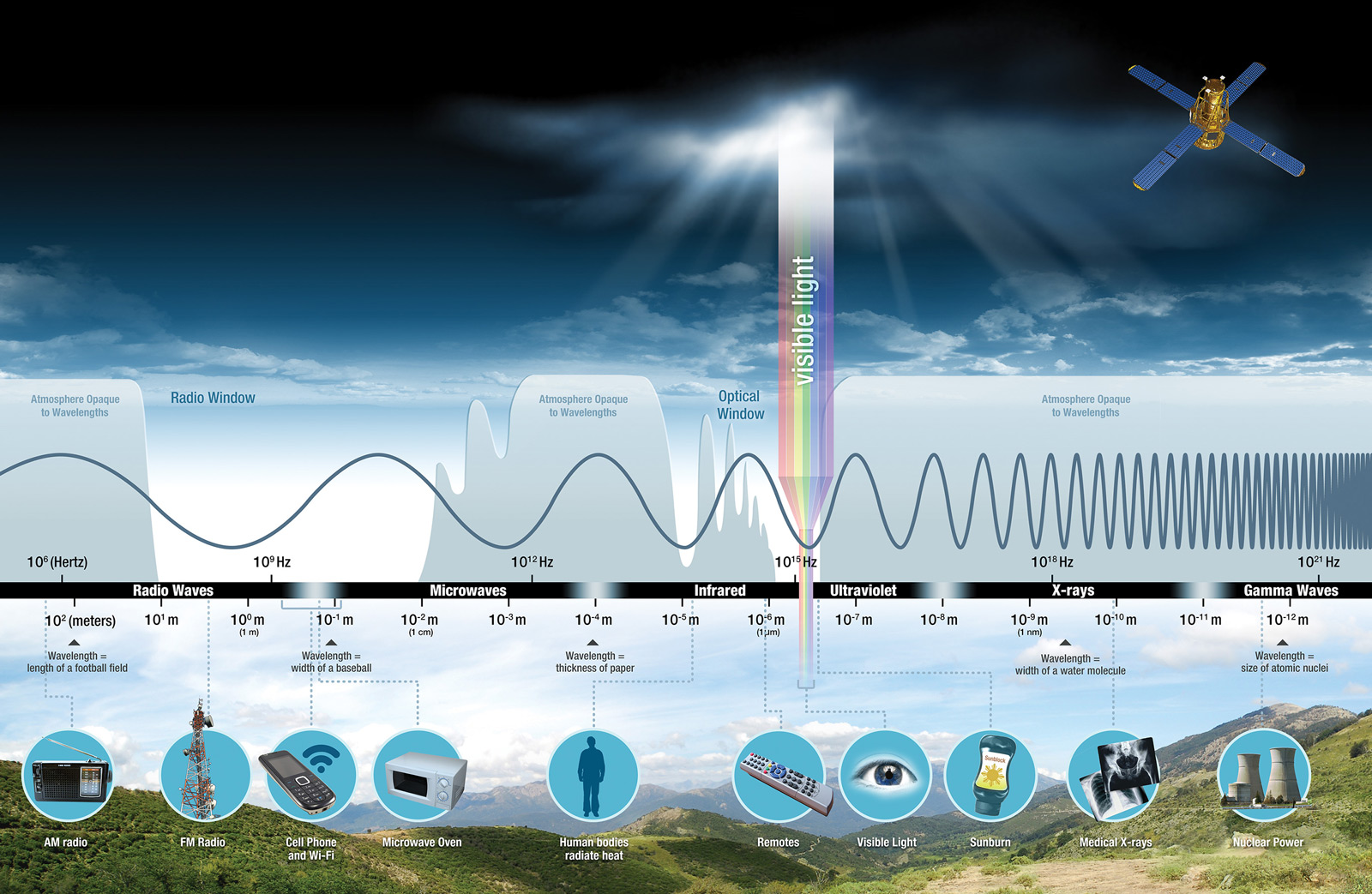
Radio waves have the lowest energies, lowest frequencies, and longest wavelengths of the electromagnetic spectrum. On Earth, we use radio waves to transmit data when we use cell phones or wireless internet. The universe is also full of radio-emitting objects like pulsars, nebulae, and some types of galaxies.
Microwaves cook popcorn in a few minutes. Astronomers use this light to learn about the structure of galaxies, including our own. NASA’s Cosmic Background Explorer (COBE) used this wavelength to map the cosmic microwave background, taking a sort of baby picture of the universe.
Infrared light is often used to detect heat. It’s what you see when you wear night-vision goggles. In space, astronomers use it to map the dust between stars and observe newborn stars. NASA’s James Webb Space Telescope employs infrared light to study some of the universe’s oldest stars.
Visible light is what our eyes detect. It’s emitted by fireflies, lightbulbs, and stars. Scientists use it to study all kinds of cosmic objects. NASA’s Transiting Exoplanet Survey Satellite, for example, uses visible light to find exoplanets, or worlds beyond our solar system.
Ultraviolet (UV) light carries more energy than visible light. Most of it is blocked by Earth’s atmosphere, but some UV rays from the Sun get through it to give us tans and sunburns. NASA’s Hubble Space Telescope uses UV light to study everything from auroras on Jupiter to star formation in other galaxies.
X-rays are so penetrating that dentists use them to see into your teeth and airport security uses them to see through bags. Astronomers study X-rays emitted by neutron stars, galaxies, and cosmic explosions with missions like NASA’s Chandra X-ray Observatory.
Gamma rays are the highest-energy form of light. They’re used to sterilize food and medical equipment and to treat some forms of cancer. Astrophysicists use them to investigate some of the most powerful events in the cosmos – explosions of massive stars and collisions of neutron stars and black holes. NASA’s Fermi Gamma-ray Space Telescope has been collecting gamma rays for over a decade and has discovered many exciting new phenomena, including two huge gamma-ray bubbles extending thousands of light-years above and below the center of our home galaxy.
Many cosmic objects and events also eject high-speed particles. In some cases, particles allow scientists to peer into places that cannot be seen with light. For example, some particles can escape extremely dense environments where even light might struggle to get out, like inside dying stars. Cosmic particles come in two classes –neutrinos and cosmic rays.
Neutrinos are fundamental particles – they can’t be broken down into smaller parts. They’re produced by radioactive decay and nuclear reactions, including those that occur in nuclear reactors on Earth, in the cores of stars, in supernova explosions, and when black holes shred stars. Neutrinos outnumber all the atoms in the universe, travel at nearly the speed of light, and rarely interact with other matter. These characteristics make neutrinos interesting, but also very hard to study.
The National Science Foundation’s IceCube Neutrino Observatory in Antarctica uses a series of instruments buried in a cubic kilometer of Antarctic ice to detect neutrino signals. Even with that volume, IceCube only sees one neutrino every six minutes. That’s one neutrino for every 500 trillion trillion that pass through the observatory in the same amount of time.
Cosmic rays
Cosmic rays are charged, high-energy particles that move through space at near-light speed. Every second, every square meter of Earth’s atmosphere is pelted by large quantities of cosmic rays. These particles are usually hydrogen nuclei, or protons. But scientists have detected examples of other subatomic particles like neutrons, electrons, and even antimatter. NASA’s Super Trans-Iron Galactic Element Recorder (SuperTIGER), a balloon-borne instrument, detected cosmic rays composed of the nuclei of heavier atoms, like cobalt or barium.
Cosmic rays are boosted to high speeds in cosmic events and environments that release a lot of energy. One example is the expanding debris of exploded stars called supernova shock waves.
Since cosmic rays are charged – positively charged protons or nuclei, negatively charged electrons – their paths through space can be deflected by the magnetic fields of stars and other objects.
Gravitational Waves
Gravitational waves are ripples in space-time, the fabric of the universe, that travel at the speed of light. Gravitational waves are created when objects speed up, slow down, or change direction. And just like light, they come in different wavelengths and frequencies. All accelerating masses generate gravitational waves, including pencils, people, and planets. But we can currently detect only those produced by superdense stellar remnants – black holes and neutron stars. Even the strongest waves detectable at Earth distort our planet’s shape by only about 1% the size of an atom.
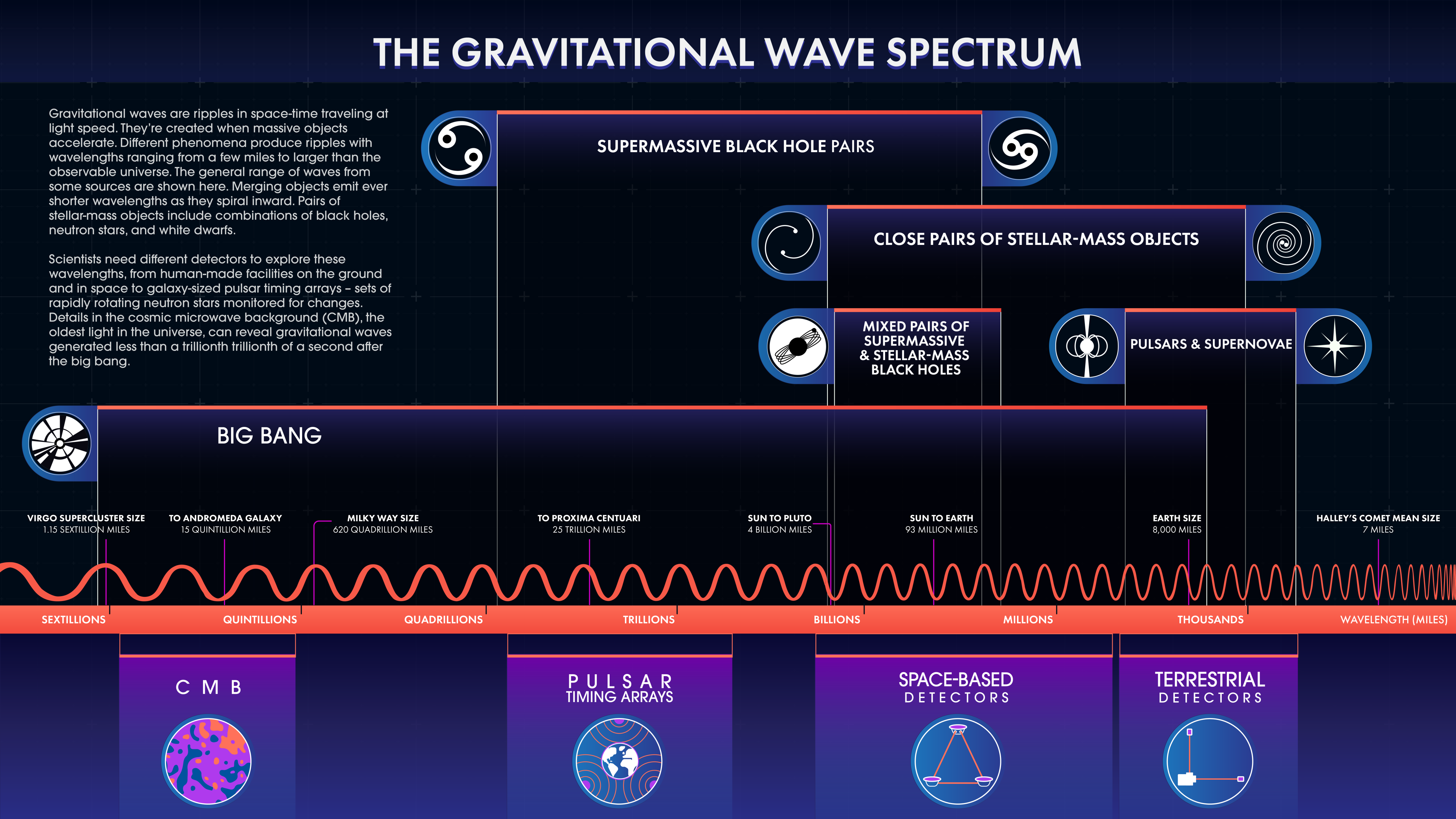
Albert Einstein predicted the existence of gravitational waves in 1916 in his general theory of relativity. Scientists gained confidence in their existence by watching the orbits of some binary systems but didn’t directly observe them until 2015 when the National Science Foundation’s Laser Interferometer Gravitational Wave Observatory (LIGO) detected ripples from the collision and merger of two stellar-mass black holes. The upcoming European Space Agency-led Laser Interferometer Space Antenna (LISA) is designed to detect gravitational waves from pairs of supermassive black holes in merging galaxies.
Scientists are also using pulsar timing arrays – specific sets of millisecond pulsars, rapidly rotating cores of stars that exploded as supernovae – to hunt for some kinds of gravitational waves. Millisecond pulsars sweep beams of radiation, from radio to gamma rays, past our line of sight, appearing to pulse with incredible regularity – like cosmic clocks. As long gravitational waves pass between one of these pulsars and Earth, they delay or advance the light arrival time by billionths of a second. By looking for a specific pattern of pulse variations among pulsars of an array, scientists expect they can reveal gravitational waves rolling past them.
Discover More Topics From NASA
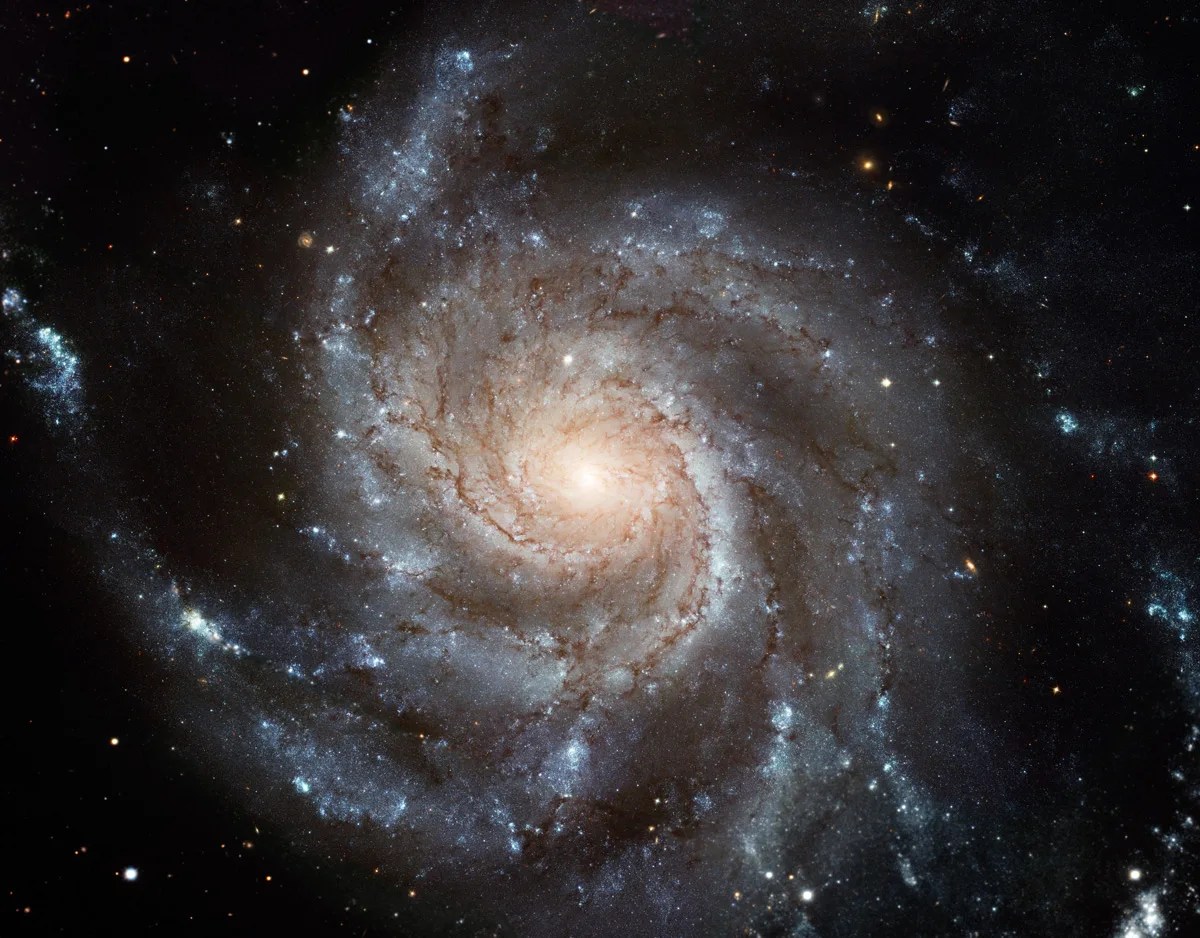
Black Holes

Reset password New user? Sign up
Existing user? Log in
Gravitational Waves
Already have an account? Log in here.
- Adam Strandberg
Gravitational waves emitted from an inspiraling binary system propagate outward like water waves [1]. In general relativity , gravitational forces between two massive bodies like planets or stars are due to the curvature of spacetime , which itself is caused by the presence of massive bodies. Gravitational waves are propagating disturbances in the curvature of spacetime, caused by some of the most violent and energetic physical processes in the universe. A common analogy in general relativity considers gravity to be caused by masses warping a rubber sheet; smaller masses tend to fall into the indentations caused by larger masses, representing the attractive effects of gravity. In this analogy, gravitational waves are "ripples" in the rubber sheet propagating outwards like waves on the surface of water.
Earth's gravitational attraction to the sun in the rubber sheet analogy [2].
Unlike in Newtonian gravity, where gravity acts instantaneously, according to special relativity all interactions including gravity cannot propagate faster than the speed of light. As part of his theory of general relativity, Einstein predicted in 1916 that gravity propagates as a wave, mediated by a massless particle called a graviton that travels at the speed of light. These particles comprise gravitational waves in the same way that photons comprise light waves.
The mathematics of gravitational waves and their detection is difficult, requiring the solution of a simplified version of Einstein's equations, applications of Fourier analysis, and extensive knowledge of quantum mechanics . Regardless, physicists have been able to predict to remarkable accuracy observable quantities such as the power radiated in gravitational waves from an inspiraling binary system of stars or black holes as well as phase shifts in laser interferometers designed to detect gravitational waves. On February 11, 2016, the LIGO Scientific Collaboration and Virgo Collaboration confirmed that they had directly observed on September 14, 2015 a gravitational wave signal from the merger of two previously mutually orbiting black holes , using laser interferometry techniques. On October 3, 2017, the 2017 Nobel Prize in Physics was awarded to the three physicists principally involved in the conception and development of LIGO: Rainer Weiss, Barry C. Barish, and Kip S. Thorne [3].
What are Gravitational Waves?
Operation of advanced ligo, mathematics of gravitational waves in general relativity.
To say that gravitational waves are propagating disturbances in the curvature of spacetime means that gravitational waves affect the distances measured between objects as they pass through them. Just like light waves, gravitational waves have different polarizations . These polarizations are characterized by how gravitational waves with a certain polarization act on a circular ring of masses. When a gravitational wave with a certain polarization passes through the ring of masses, it distorts the locations of the masses in a characteristic pattern. The two polarizations of gravitational waves are referred to as "\(+\)" and "\(\times\)" polarizations, corresponding to the two characteristic patterns of oscillation over time of a circular ring of masses as gravitational waves with these polarizations pass through them:
Left: oscillations of a ring of masses as a \(+\) polarized gravitational wave passes through them. Right: the same effect with a gravitational wave of \(\times\) polarization [1].
The relative change in measured distance between two masses as a gravitational wave passes through them is referred to as the strain .
A particularly strong source of gravitational waves is inspiraling binary systems. These are two stars or black holes orbiting around their common center of mass. As they shed gravitational waves (and thus energy) throughout their orbit, the radius of orbit decreases slowly until the stars/black holes collide. If two stars/black holes each of mass \(M\) are mutually orbiting at angular frequency \(\Omega\) and radius \(R\) to their center of rotation, the magnitude of strains at a distance \(r\) from the binary system oscillates as a function of time \(t\), roughly [4]:
\[h = \frac{8GM}{rc^4} \Omega^2 R^2 \cos \left(2\Omega \Big(t - \frac{r}{c} \Big) \right),\]
where \(G\) is Newton's gravitational constant and \(c\) is the speed of light. The magnitude of the strains caused by gravitational waves thus falls off inversely proportional to the distance from the source. Since most binary systems of stars/black holes are far away from Earth, the strongest signals for gravitational waves will come from either very massive or very rapidly rotating binary systems. Even so, the strains caused by gravitational waves from most systems are on a scale of roughly \(h = 10^{-26}\). This means that if two masses are separated by a distance of \(L\), the change in separation \(\Delta L\) caused by the passing gravitational wave satisfies
\[\frac{\Delta L}{L} = h \approx 10^{-26}.\]
Note that the strain is unitless since both the numerator and denominator of the left-hand side have units of length. Even the strongest known gravitational wave signals cause strains of order only \(h \approx 10^{-20}\). As a result, it is very difficult to directly measure gravitational wave signals, since few experimental apparatuses can detect such minute strains.
The radius of a proton is about \(10^{-15}\) meters. If a \(4 \text{ km}\) arm of the Advanced LIGO apparatus is displaced by just the radius of a proton, what strain does this correspond to? (What does this say about the detectability of gravitational waves?)
In addition to causing the oscillation of a system of free masses, gravitational waves also cause a so-called memory effect , in which a free system of masses through which gravitational waves have passed is permanently displaced from its initial configuration. Recent work in high-energy physics has investigated the existence of memory effects for the other fundamental forces of nature as well.
Since direct signals of gravitational waves are miniscule, for decades the only evidence for the existence of gravitational waves was indirect. Rather than directly observing strains caused by the gravitational waves, astronomers were able to observe in 1974 a decrease in the period of rotation of a binary star system over time due to energy loss to gravitational waves. This system, known as PSR B1913+16 or the Hulse-Taylor binary after its discoverers, consists of a neutron star and a pulsar (radiating neutron star). Neutron stars are very dense and small, so the period of rotation of this system was very small. A pulsar emits radiation in a beam which can only be observed when pointing towards Earth, thus providing a highly accurate clock with which to measure the period of rotation. According to general relativity, the power radiated by such a binary system is [4]
\[P = -\frac25 \frac{G^4 M^5}{c^5 R^5},\]
where \(M\) is the mass of each star (assuming they are approximately equal), \(R\) is the distance of each star to the center of rotation, and \(G\) is Newton's gravitational constant. This power loss causes the binary system to inspiral at a faster and faster rate, since once the system begins to inspiral faster it emits gravitational waves faster, which in turn causes faster inspiral. Below is plotted the data from the Hulse-Taylor system for change in the period of rotation over time, compared to the prediction from the theory of gravitational waves. The agreement is remarkable:
Red dots represent measurements of the period of rotation of the Hulse-Taylor binary system, overlaid on the blue curve representing the theoretical model [5].
Two black holes in a mutually orbiting binary system both have mass \(M\) and orbit at radius \(R\) to their center of rotation.
What is the magnitude of the rate of change of their radius (the rate at which they inspiral due to energy loss to gravitational radiation)?
Assumptions and Details:
- The power radiated in gravitational waves by an inspiraling binary is \(P = -\dfrac25 \dfrac{G^4 M^5}{c^5 R^5}.\)
- Apart from the expression for gravitational wave radiation, assume Newtonian mechanics applies.
Suppose that an inspiraling black hole binary system is at radius \(R_0\) at time \(t=0\) and that the radius of the binary changes as
\[\frac{dR}{dt} = -\frac{\kappa}{R^3}\]
for some constant \(\kappa\). What is the period shift in the rotation of the binary as a function of time (taking the shift to be zero at \(t=0\)), noting that the frequency of rotation in a Hulse-Taylor binary is
\[\Omega = \left(\frac{GM}{4R^3}\right)^{1/2}?\]
Although the strains caused by gravitational waves are miniscule, they can be measured directly using techniques of laser interferometry. This is the technique used by the Advanced Laser Interferometer Gravitational-wave Observatory (Advanced LIGO), which directly detected gravitational waves on September 14, 2015 from a binary black hole merger now called GW150914.
An aerial view of one of the Advanced LIGO detectors.
The Advanced LIGO apparatus consists of two Michelson interferometers , located in Hanford, Washington, USA and Livington, Louisiana, USA, which are sensitive to strains of order down to \(h\approx 10^{-22}\). Two detectors are necessary because a single detector would not be able to detect the position of a gravitational wave source and in order to provide additional verification of an apparent signal. Each detector consists of two arms of four kilometers in length. Light from a \(1064 \text{ nm}\) Nd:YAG laser enters a beam splitter, which splits the beam into each arm of the detector. In each arm, the laser light is amplified to a power of \(100 \text{ kW}\) by bouncing between two mirrors ("test masses") located at either end of the arm. A passing gravitational wave changes the distance between the mirrors by a factor given by the strain of the gravitational wave.
Schematic of the Advanced LIGO apparatus, a modified Michelson interferometer. Laser light bounces through the arms repeatedly, picking up small phase shifts from any displacement of the mirrors due to gravitational waves. This translates into an interference pattern seen at the photodetector [5].
The detector arms are highly insulated from both seismic noise and thermal noise, since any minute vibrations due to Earth's tectonic activity or thermal fluctuations would vastly overwhelm gravitational wave signals. The mirrors between which the laser bounces in each arm are suspended on vibration-isolating stages and kept in extreme vacuum conditions at temperatures around a millionth of one Kelvin, at such a low energy that the mirrors themselves are near their quantum ground state [7].
A difficult effect to control for is the quantum fluctuation in the number of photons in the lasers in the cavity. This is a problem because light exerts a pressure on objects when it reflects from them; therefore, uncertainty in photon number translates into an uncertain/fluctuating amount of pressure on the mirrors in the cavity which could overwhelm the displacements on the mirrors due to gravitational waves. In lasers, the fluctuation in photon number scales as the square root of the number of photons. Although this fact makes it seem like using a less energetic laser would reduce this problem, there exists a number-phase uncertainty relation which means that the phase of the light would become more uncertain as the number of photons became more certain, which would also pose a problem for measuring strains, as discussed below.
The changing displacement between the mirrors in each arm is measured by taking advantage of the fact that light has a phase. If the distance between mirrors increases by a tiny amount, the laser light in the arm will travel a little extra piece of a wavelength before bouncing off of the mirrors and thus will shift its phase angle slightly. In Advanced LIGO, the laser light in each cavity is repeatedly cycled from end to end of each arm, picking up a small phase accumulation each time. This ultimately amplifies any gravitational wave strain by three hundred times [6].
Finally, the beams are recombined at the beam splitter. As a result of the accumulated phase shift, the wavelike nature of light will cause an interference pattern on a photodetector. From this interference pattern, the displacement of the mirrors and thus the strain of the gravitational waves can be measured.
If the laser light used in Advanced LIGO is \(1064 \text{ nm}\), an arm of the detector is \(4 \text{ km}\) long, and the GW150914 system causes strains \(h = 10^{-21}\), what is the phase shift in laser light traversing a detector arm at maximum displacement versus no displacement, in radians?
\(\) See Gravitational Waves.
Below is a plot of the theoretically expected signal for the strain in the Advanced LIGO detector throughout the process of a black hole merger. As the black holes inspiral rapidly right before combining, there is a rapid oscillatory burst that rings down to steady state.
As the black hole separation decreases, the black holes rotate rapidly around each other, releasing gravitational waves towards the detector in a large burst [6].
Finally, the data experimentally observed at Advanced LIGO is presented below. As illustrated, not only does the data agree well with the model, but in fact the sound of the black hole merger can be directly heard in a characteristic "chirping" noise as the binary black hole system released a massive burst of gravitational waves in its final instants before merging.
Top left: strain over time in the Washington detector. Top right: strain over time in the Louisiana detector, with the data from the Washington detector overlaid. Second row: theoretical models from general relativity for the strain over time for the signal from this binary black hole merger. Third row: an essentially random residual plot, showing that there are no serious systematic errors. Last row: the frequency spectrum over time of the gravitational wave signal in each detector. As time passed, the strongest frequency signal increases, corresponding to a "chirping" noise [6].
The signal demonstrates quite remarkable and beautiful agreement with the theoretical model computed numerically from the equations of general relativity. The black holes involved in the merger were computed to have masses \(29^{+4}_{-4}\) and \(36^{+5}_{-4}\) times the mass of the sun, with the final merged black hole mass of \(62^{+4}_{-4}\) times the mass of the sun. The burst of gravitational waves observed at LIGO therefore contained three solar masses worth of energy, keeping in mind Einstein's conversion between mass and energy \(E=mc^2\). The signal strength had a statistical significance of \(5.1\,\sigma\), meaning that the probability such a signal is a false positive is \(0.000036\%\). As quoted from Advanced LIGO's paper, "this was the first direct detection of gravitational waves and the first observation of a binary black hole merger" [6].
In general relativity , the way measured distances change as a function of space and time is encoded by a mathematical object called a metric . To understand the mathematics of gravitational waves, it is essential to understand what a metric is and how it is represented. Here is a short summary: a metric is a matrix, the components of which describe the factor by which measured distances are changing. In general, the components of the metric are functions of space and time. Gravitational waves will turn out to be perturbations to the flat metric of spacetime that obey the wave equation.
Explicitly, gravitational waves are represented as perturbations to the flat Minkowski metric, i.e. the metric is written as
\[g_{\mu \nu} = \eta_{\mu \nu} + h_{\mu \nu},\]
where \(\eta_{\mu \nu}\) is the Minkowski metric \(\text{diag} (-1,1,1,1)\) and \(h_{\mu \nu}\) is a small perturbation, i.e. each component is of magnitude much smaller than one. The invariant interval for the full metric \(g_{\mu \nu}\) can be written as follows [4]:
\[ds^2 = -(1+2\Phi)dt^2 + w_i \big(dt dx^i + dx^i dt\big) + \big[(1-2\Psi)\delta_{ij} + 2s_{ij}\big] dx^i dx^j,\]
where \(\Phi\), \(w_i\), \(\Psi\), and \(s_{ij}\) describe the different possible kinds of perturbations. The perturbation \(s_{ij}\) is a traceless symmetric tensor which will turn out to represent gravitational waves or their constituent particle, the graviton . Because \(s_{ij}\) is a matrix, it is often called the tensor perturbation to the metric; it is traceless because its trace has been separated out into the \(\delta_{ij}\) term above. It is an interesting problem to compute the degrees of freedom of \(s_{ij}\), as in the problem below, because this is how the gravitational modes of a string are identified in string theory .
How many degrees of freedom does the graviton have? That is, how many independent components are in a \((d-2) \times (d-2)\) traceless, symmetric, square matrix?
In a particularly nice coordinate system called transverse gauge , plugging this metric into Einstein's equations gives all of the perturbations to be zero except for \(s_{ij}\), which satisfies the wave equation
\[\Box s_{ij} = 0 \iff \frac{1}{c^2} \frac{\partial^2 s_{ij}}{\partial t^2} = \frac{\partial^2 s_{ij}}{\partial x^2} + \frac{\partial^2 s_{ij}}{\partial y^2} + \frac{\partial^2 s_{ij}}{\partial z^2}.\]
Since all perturbations except \(s_{ij}\) are zero in this gauge, it is common to just work with \(h_{\mu \nu}\) directly, which just looks like the matrix
\[h_{\mu \nu} = \begin{pmatrix} 0 & 0 & 0 & 0 \\ 0 &&&\\0&&2s_{ij} & \\ 0 &&& \end{pmatrix}.\]
The components of \(h_{\mu \nu}\), i.e. the components of \(s_{ij}\), are exactly the strains \(h\) mentioned above, but in different directions for each component. The "\(+\)" and "\(\times\)" polarizations discussed above refer to the two possible actions of these strains on geodesics of particles moving in this perturbed metric. Using this formalism and more extensive mathematics in general relativity, the formulas quoted above for the magnitudes of strains as a function of space and time and power radiated by a binary black hole system can be computed.
[1] Image from https://en.wikipedia.org/wiki/Gravitational_wave under Creative Commons licensing for reuse and modification.
[2] K. McLin, C. Peruta, and L. Cominsky. Direct Observation of Gravitational Waves: Educator's Guide . SSU Education and Public Outreach Group, Sonoma State University, Rohnert Park, CA. https://dcc.ligo.org/public/0123/P1600015/004/LIGOEdGuide_Final.pdf
[3] "The Nobel Prize in Physics 2017". Nobelprize.org. Nobel Media AB 2014. Web. 4 Oct 2017. <http://www.nobelprize.org/nobel_prizes/physics/laureates/2017/>
[4] Carroll, Sean. Spacetime and Geometry: An Introduction to General Relativity . San Francisco: Pearson, 2004.
[5] Weisberg, J.M.; Taylor, J.H. (July 2005). The Relativistic Binary Pulsar B1913+16: Thirty Years of Observations and Analysis . Written at Aspen, Colorado, USA. In F.A. Rasio; I.H. Stairs. Binary Radio Pulsars. ASP Conference Series. San Francisco: Astronomical Society of the Pacific. p. 25.
[6] B.P. Abbott, et al. Observation of Gravitational Waves from a Binary Black Hole Merger . PRL 116 , 061102 (2016).
[7] B.P. Abbott, et al. Observation of a kilogram-scale oscillator near its quantum ground state . New Journal of Physics, Volume 11, July 2009. http://iopscience.iop.org/article/10.1088/1367-2630/11/7/073032/meta;jsessionid=DC52784888F8C04DC86C16069DE35826.c2.iopscience.cld.iop.org
Problem Loading...
Note Loading...
Set Loading...
National Aeronautics and Space Administration
Goddard space flight center, imagine the universe, astronomer's toolbox.
- Cosmic Objects
- Big Questions
- Featured Science
- Observatories
- Scientist Profiles
- You Be the Astrophysicist
- The Cosmic Distance Scale
- Lesson Plans
- Ask an Astrophysicist
- Other Resources
- News #include virtual="/news/newsNav.html"
Additional Links
Related Topics
Gravitational Waves
One way to describe gravitational waves is as "ripples in space-time." They were predicted a century ago by Einstein's Theory of General Relativity . His theory describes how space-time is affected by mass . We can think of space-time as a fabric that bends or curves when we place an object on it. (Of course, space is actually 3-dimensional, plus the added dimension of time.)
Imagine pulling a sheet tight between several people and placing a bowling ball in the center of it. The mass of the ball would cause the sheet to curve. The curve is weak far away from the ball, and steeper near the ball. In fact, the sheet is a bit stretched in the area near the ball, as well. This is analogous to the curvature of space-time in the presence of mass. Near a mass, space-time curves more drastically and stretches. Near a very large mass, the 'dent' in space-time is very deep.

Illustration of how space-time curves in the presence of a massive object – in this case, the Earth. (Credit: NASA's Imagine the Universe)
To take the analogy of the sheet one step further, imagine that you had two bowling balls on the sheet, and they were orbiting each other's common center of mass. This would cause ripples in the sheet to move from the bowling balls outward. In space-time, these are the ripples we would call gravitational waves, and they travel at the speed of light .
Where Do Gravitational Waves Come From?
Gravitational waves are produced by masses moving through space-time in a special way. The simplest system that produces gravitational waves is two masses orbiting their common center of mass.
One of the most common such system is a binary star system – two stars orbiting each other's common center of mass. It turns out that about half of the stars you see in the sky are members of a binary system. And those stars can be at any stage of their life cycle, which means you can have any combination of a normal star, giant star, white dwarf , neutron star , or black hole . Another place you might find large masses orbiting each other is the center of a galaxy - if two galaxies merged, their central supermassive black holes would orbit for a long time before they also merged.
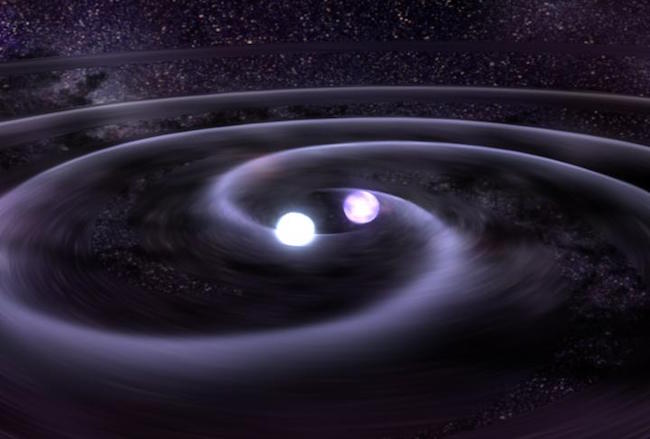
Artist's impression a neutron star merger and the gravitational waves it creates. (Credit: NASA/Goddard Space Flight Center)
As the black holes, stars, or galaxies orbit each other, they send out waves of "gravitational radiation" that travel at the speed of light . The waves that reach us are extremely weak because, like water waves, gravitational waves decrease in strength as they move outward. Despite being weak, the waves can travel unobstructed within the 'fabric' of space-time, providing us with information that light cannot.
How Can We Detect Gravitational Waves?
The detection of gravitational waves requires measurements that detect changes in distance less than the size of an atomic nucleus - that's tiny! To do this, scientists use interferometry, which consists of two parts: test masses separated by a distance and lasers to measure that distance.
Test masses are set at a large distance from each other – the large distance helps make any change in their distance be large enough to measure. The masses are then shielded from all disturbances except gravity , which we cannot shield against.
Then lasers make continuous measurements of the distance between each of the test masses. The masses are free to move in response to gravity so that when a gravitational wave passes, space-time stretches and the time it takes light to travel between the masses changes.
Gravitational waves were first detected by the ground-based LIGO detectors in 2015 using ground-based facilities in Washington and Louisiana. The Virgo detector in Italy spied its first gravitational wave in 2017. A space-based observatory called LISA is scheduled to launch in the early 2030s as part of the European Space Agency's Cosmic Visions Program.
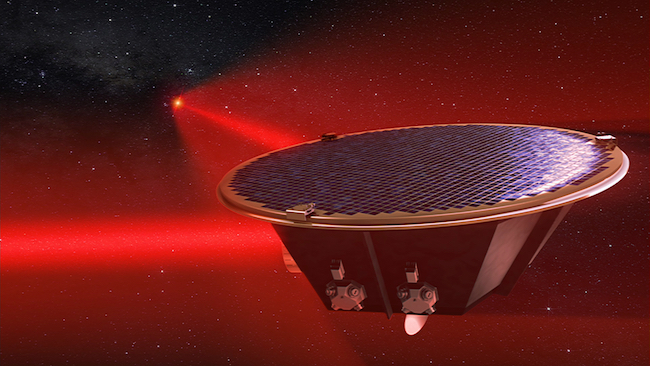
Artist's impression of a Laser Interferometer Space Antenna ( LISA ) mission concept spacecraft. LISA is a space-based observatory of gravitational waves consisting of a constellation of three spacecraft, with launch planned for 2034. It is the third large mission (L3) in ESA's Cosmic Vision plan. (Copyright: AEI/Milde Marketing/Exozet)
What Will We Learn From the Detectors?
Gravitational waves are helping physicists and astronomers to understand some of the most fundamental laws of physics. They tell us about the dynamics of large-scale events in the universe like the formation and growth of galaxies and the supermassive black holes at their centers. With LISA, scientists will be able to probe through space and time, to observe the universe just a fraction of a second after the Big Bang . Using this information, we may be able to learn more about how the universe began and evolved.
Text updated: October 2017

- Project Leader: Dr. Barbara Mattson
- Web Curator: J.D. Myers
- Responsible NASA Official : Dr. Andy Ptak
- Privacy Policy & Important Notices
- Page Last Updated: 11-Oct-2017
- Adler Anywhere
- Venue Rentals
- Ask Adler Astronomers
- Save with CityPASS
- Star Pass Portal
- Group Visits
- School Field Trips
- Digital Series
- Collections
- The Adler ‘Scope Blog
- Kids and Family
- Educator Hub
- Community of Stargazers
Home » Blog » What Are Gravitational Waves And How They Helped Us Discover The “Mass Gap” Black Hole
What Are Gravitational Waves And How They Helped Us Discover The “Mass Gap” Black Hole
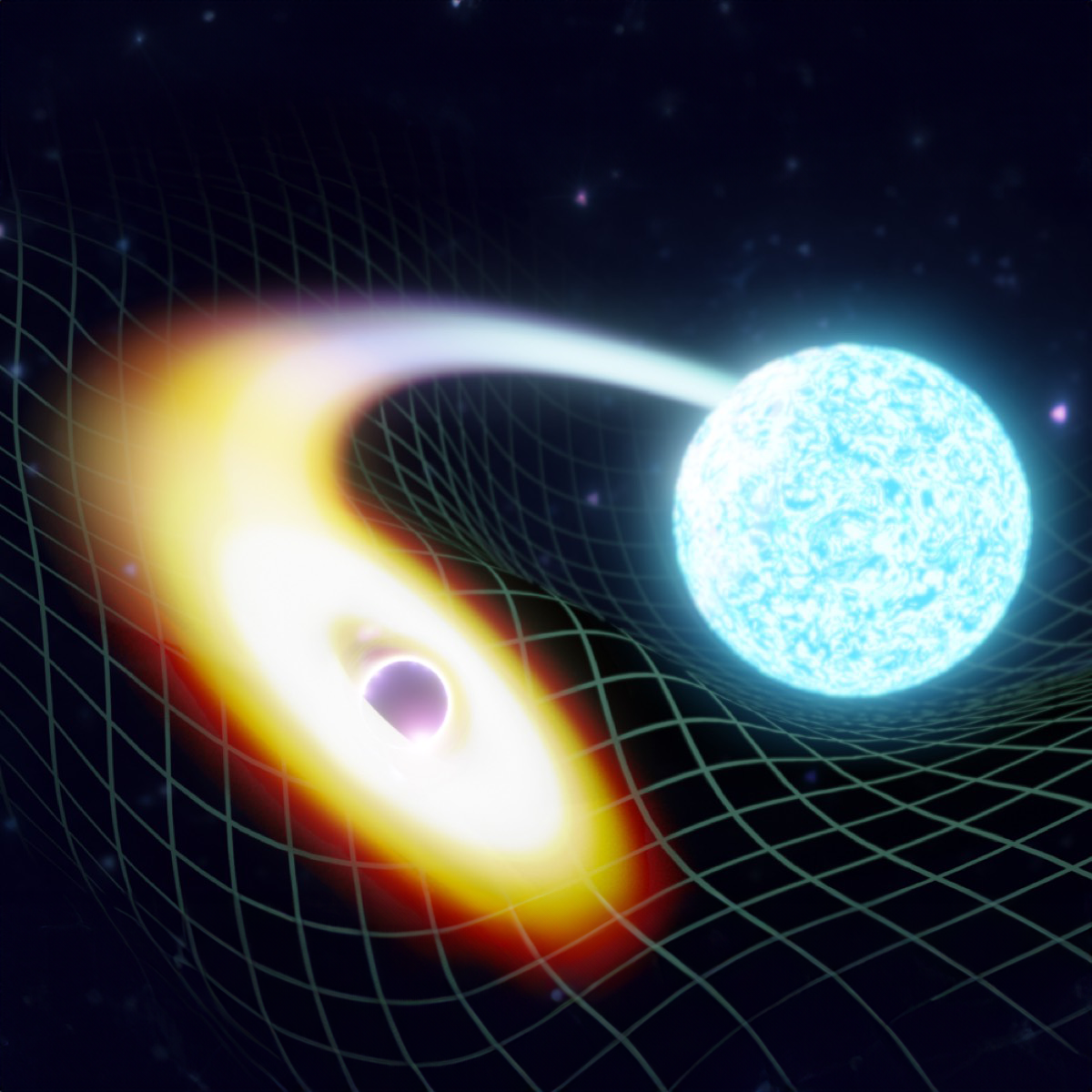
Header Image: Artistic rendition of a black hole merging with a neutron star. Image credit: LIGO-India/ Soheb Mandhai
Written by The Adler Planetarium’s Astronomer, Dr. Michael Zevin.
Humanity’s understanding of the universe has evolved in parallel with new methods of observing the cosmos. Our ancient ancestors tracked and cataloged the motion of heavenly bodies, and by the early 17th century, the invention of the telescope allowed us to observe dimmer, more distant objects. In the 19th century, we began relying on astronomical photography—which allows us to expose images of the universe for longer periods of time—and astronomical spectroscopy—which breaks apart light into its constituent colors.
By the 20th century, we could observe the universe in energies and colors of light that the human eye cannot see and we finally bypassed Earth’s atmosphere by sending telescopes into space. All of these advancements have improved our understanding of the cosmos, unveiling new mysteries in the process.
What you may not realize is that there is a commonality between all of these astronomical advances. They all rely on collecting a single form of information—electromagnetic radiation, which you may know better as “light.” For almost the entire history of astronomy, light has been the sole cosmic messenger we’ve used to glean information from the vast universe beyond our solar system.
However, it is still only one form of information, one sense that we can collect information with. What could we learn if we were able to collect information using other senses? Rather than just seeing the universe, what else would we discover if we could hear it or feel it?
Gravitational Waves
There are other messengers from the universe beyond just light. One of these messengers is called gravitational radiation or gravitational waves . This phenomenon was predicted by Albert Einstein over a century ago as a byproduct of his theory of general relativity. The theory of general relativity is our modern understanding of how gravity, space, and time operate in the universe. In a nutshell, it tells us that matter and energy curve the fabric of space. This curved space tells things like planets, stars, and galaxies how to move. If objects are accelerating through the malleable fabric of space, they create ripples in the fabric of space itself.
These gravitational waves travel at the speed of light and are completely invisible to a telescope, but provide information from the universe, completely independent from light! The direct detection of gravitational waves is analogous to hearing the sounds of the universe for the first time and can unveil unprecedented information about astrophysical objects that are notoriously difficult to study with light, such as black holes.
The Best Rulers Ever Built
If gravitational waves are invisible, how can we detect them? As gravitational waves pass through space, they cause space itself—and everything within it—to expand and contract. For example, when a gravitational wave passes through our planet, it causes the equator to stretch, and the distance between the poles to squeeze, ever so slightly—and vice versa.
However, spacetime is exceptionally “stiff” and even the strongest gravitational waves have an unbelievably minuscule effect. For example, a passing gravitational wave from the collision of two black holes might stretch and squeeze the Earth by about the width of a proton, which is about a thousand trillionth of a meter. In fact, these signals are so elusive that even Einstein himself thought that we would never be able to detect them and use them to study the cosmos.
To observe gravitational waves, we use high-powered lasers that act as an incredibly precise ruler. The LIGO–Virgo–KAGRA gravitational-wave network does this with four separate detectors around the world: the twin LIGO detectors in Washington and Louisiana, the Virgo detector in Italy, and the KAGRA detector in Japan.
These detectors are giant L-shaped devices with two arms that are each 2.5 miles long vacuum chambers. The laser is sent down the two arms, bounces off mirrors at the ends of the arms, and comes back to interact with the light that went down the other arm. Because of the wave-like nature of the light in the lasers, we can detect interference when the two light beams recombine if the arms have a slight difference in length from a passing gravitational wave.
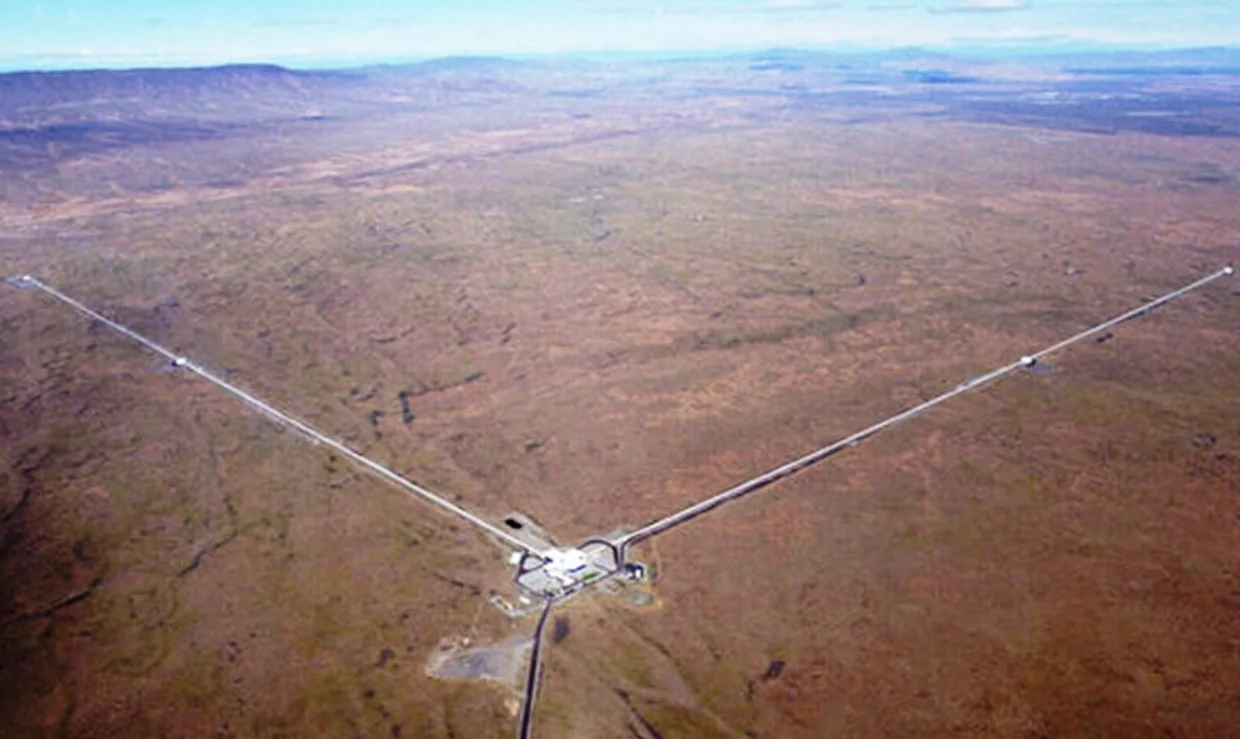
Sounds Of Spacetime
On September 14, 2015, almost exactly a century after Einstein predicted the existence of gravitational waves, a screaming loud signal was observed in the LIGO detectors. Based on how the arms of the LIGO detectors wiggled, we could tell a lot about the system that created the gravitational-wave signal: two black holes about a billion lightyears away, each about 30 times the mass of the Sun, spiraling towards one another and merging. This signal was one of the most monumental discoveries in modern physics, and was awarded the Nobel Prize in Physics in 2017. For the first time, we were able to hear the sounds of spacetime and use gravitational waves as a new sense to collect information from the universe!
Since this discovery, the field of gravitational-wave astronomy has exploded. The last full observing run of gravitational-wave detectors completed in 2020, and at that time nearly 100 confident gravitational-wave events were observed. These didn’t just come from merging black holes; the dense remnant cores of massive stars called neutron stars were also observed in gravitational waves.
In fact, one infamous system of two merging neutron stars was observed in both electromagnetic and gravitational radiation—a “multi-messenger” event! When two neutron stars merge, they not only emit gravitational waves, but also a burst of high-energy radiation called a gamma-ray burst and an explosion powered by radioactive decay called a kilonova. Kilonovas create a beautiful light show and are responsible for synthesizing most of the heavy elements on the periodic table (so you can thank them for generating the gold, silver, and platinum we have here on Earth).
Despite the groundbreaking gravitational-wave discoveries during the first half-decade of observations, the field of gravitational-wave astronomy is still in its nascent stages. The network of gravitational-wave detectors turned back on for another observing run in May 2023. Soon after, another new and exciting system was observed.
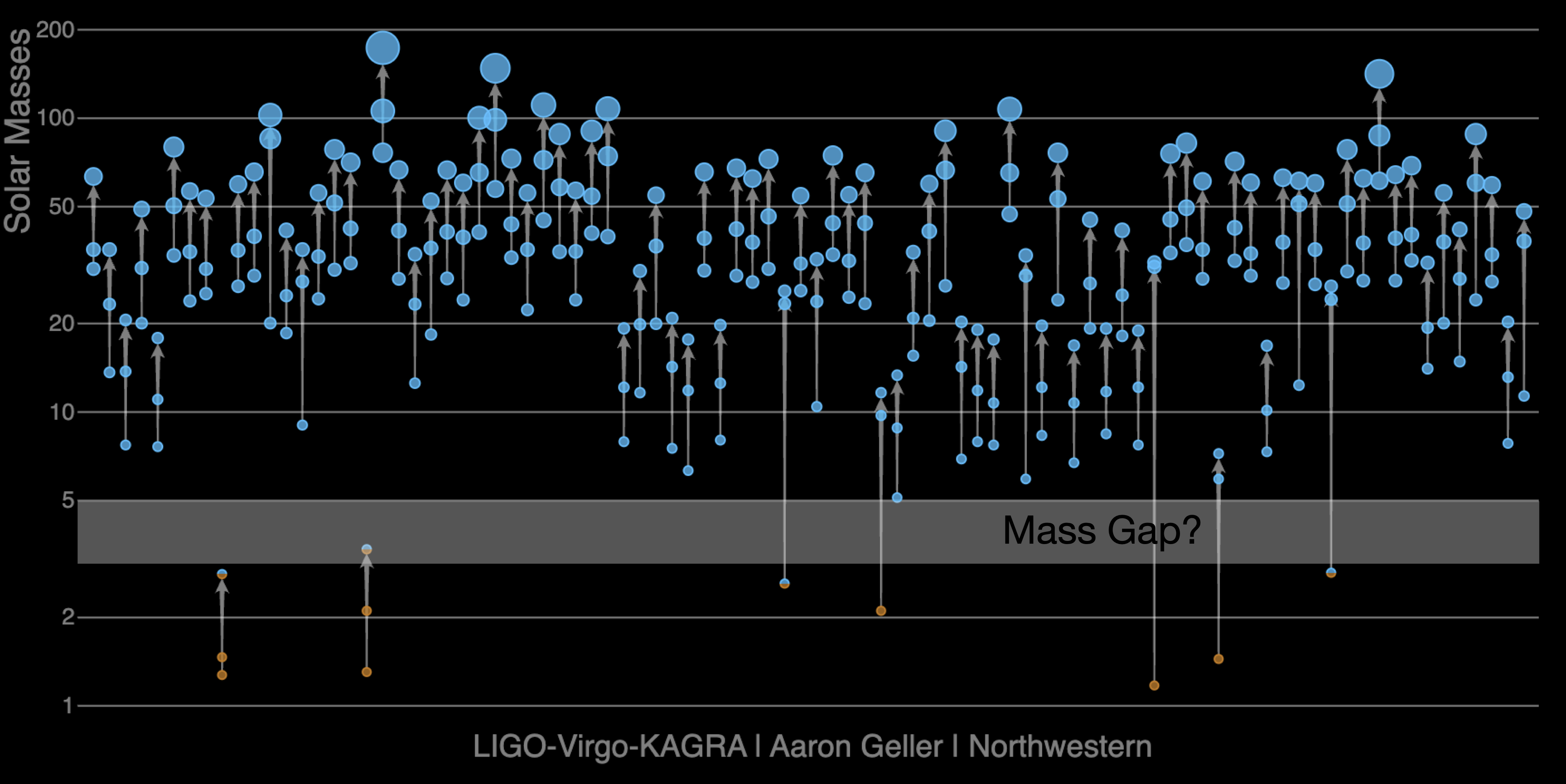
GW230529: A Black Hole In The Mass Gap
On May 29, 2023, gravitational waves were detected from a new type of system. I was fortunate to co-lead the discovery paper of this system on behalf of the almost 2,000 LIGO–Virgo–KAGRA collaboration scientists around the globe. The gravitational-wave event, dubbed GW230529 (“GW” for “gravitational wave” and its phone number “230529” for the year, month, and day of the detection), was seen only by the LIGO detector in Louisiana; all other detectors were either offline or not sensitive enough to see it.
Although we are confident that it is a real astrophysical event and not some source of noise, gravitational-wave detectors are somewhat like omnidirectional microphones. Without multiple detectors to triangulate the signal, we couldn’t determine where in the sky it came from. However, we can tell that the system was about 650 million lightyears away, meaning the gravitational waves were sent out a long, long time before even dinosaurs were around. We could also tell how massive the two objects in the system were, which was the real kicker.
Since the late 1990s, astronomers have hypothesized that there might be a “gap” between the heaviest neutron stars and the lightest black holes. Neutron stars can sustain themselves up to somewhere between two–three times the mass of the Sun before they can’t withstand the force of gravity anymore and collapse into a black hole (the exact “maximum mass” of a neutron star is a hot topic in astrophysics).
We’ve also indirectly inferred the masses of black holes in our own galaxy, the Milky Way, in systems called X-ray binaries. An X-ray binary is where a black hole is in a binary system with a star and stealing material from it. Based on how the star moves in the sky, we can tell the mass of the invisible black hole. It turns out that the lightest black holes observed in the Milky Way were no less than five times the mass of the Sun! Therefore, there seemed to be a gap in the masses of neutron stars and black holes that is between three–five times the mass of the Sun.
Is there a reason these lightweight black holes don’t form? Astronomers came up with theories about how the supernovae that form black holes can avoid this regime of masses. However, it is also possible that there is something we don’t quite understand about the biases of observing black holes in X-ray binary systems.
The black hole in GW230529 falls squarely in this “mass gap,” with a mass that is likely three–four times the mass of the Sun. This gravitational-wave event is one of the best pieces of evidence that lightweight black holes can exist in nature. The black hole in the system is also in the running for being the lightest black hole ever observed!
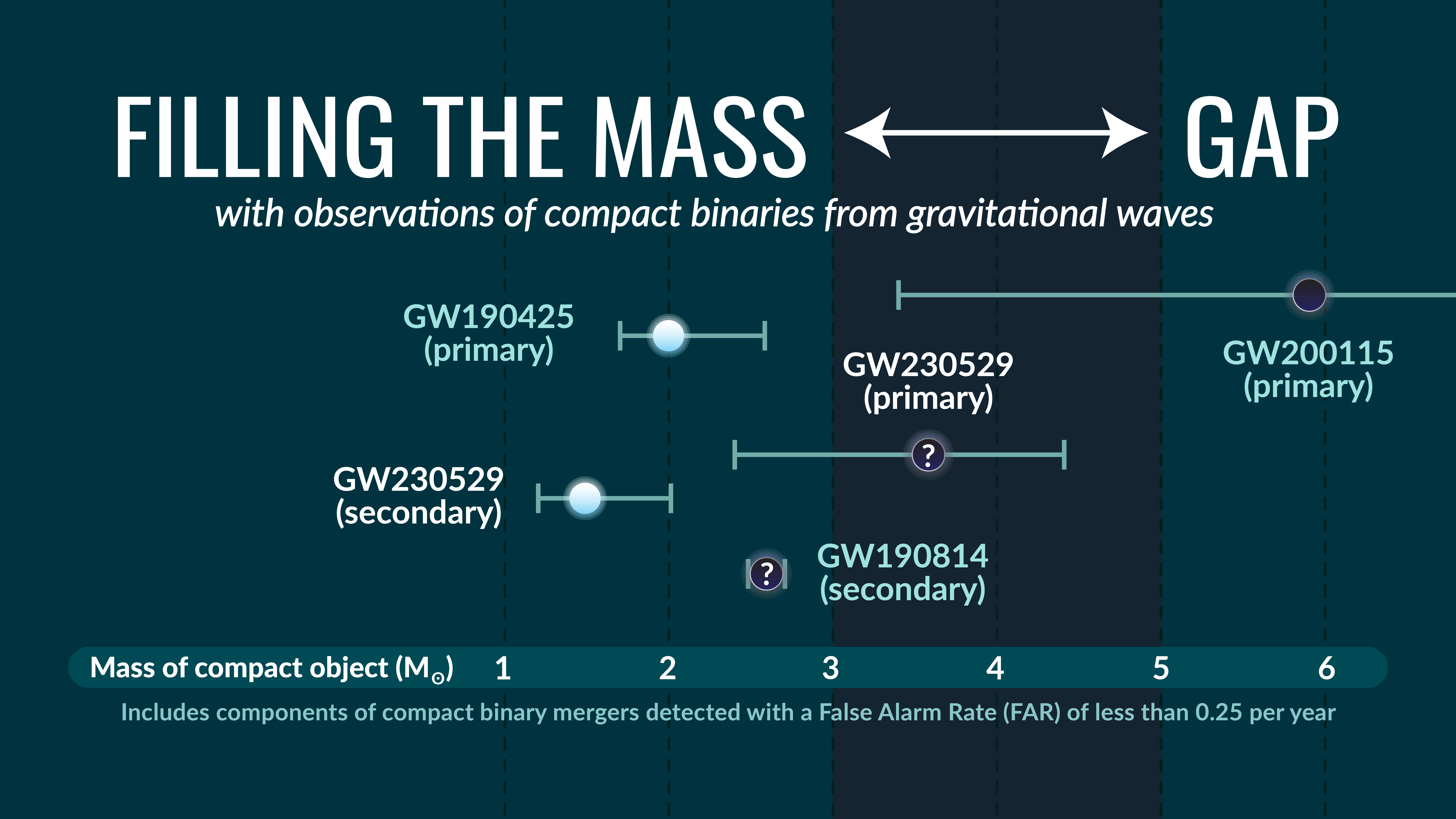
Despite how much mass they contain, black holes are amazingly small for their weight. At a few times more massive than the Sun, the black hole we observed could fit comfortably within the city of Chicago! This is wild, considering that we can see the way it distorts spacetime at a distance of 650 million lightyears—about four billion trillion miles.
The lighter object in the system was likely a neutron star. When neutron stars merge with another compact object like a black hole or another neutron star, they can get ripped apart and create a kilonova. However, if a neutron star merges with a black hole that is too heavy, it will get swallowed whole by the black hole before it can get torn to shreds, without emitting light or synthesizing heavy elements. Although we did not observe a kilonova alongside GW230529 (we couldn’t tell where in the sky it came from, which makes it exceedingly difficult to find an electromagnetic counterpart), the small black hole in the GW230529 system also tells us that black holes can indeed tear apart neutron stars before swallowing them whole.
More exciting gravitational-wave discoveries are on the horizon. Until then, keep looking up!
DISCOVER MORE POSTS
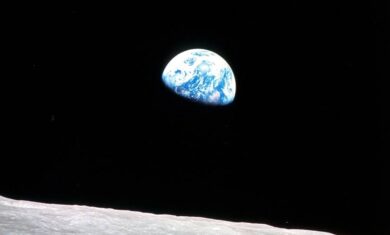
What Is Home To You?
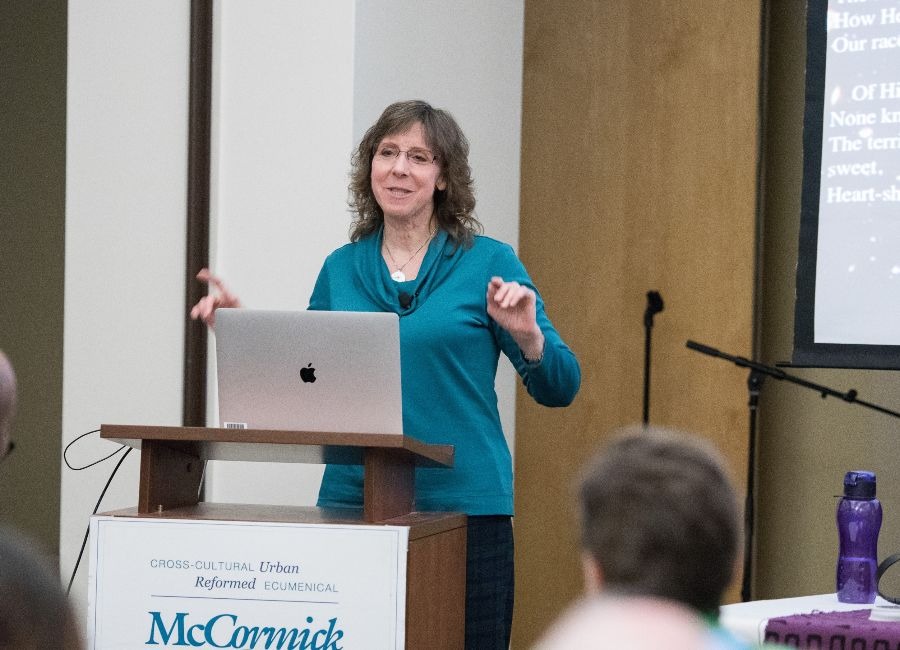
The Universe that unites us
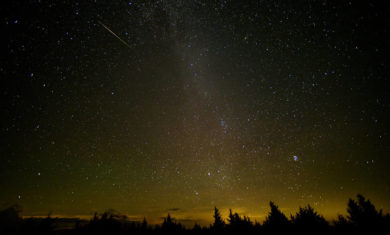
Adler Skywatch: August 2021
1300 S. DuSable Lake Shore Dr. Chicago, IL 60605
Open Today From 4pm – 10pm
*Last admission one hour before close.*
- Plan Your Visit
We all have the potential to discover something great. Help the Adler unlock the potential in every mind with a tax-deductible gift.
- Annual Reports & Financials
- Career Opportunities
- Private Events
- Sign Up For Our Emails

What are gravitational waves?
Gravitational waves are created by some of the most powerful events in the universe.
Gravitational waves are distortions in the fabric of space and time caused by the movement of massive objects, like sound waves in air or the ripples made on a pond's surface when someone throws a rock in the water. But unlike sound waves pond ripples, which spread out through a medium like watter, gravitational waves are vibrations in spacetime itself, which means they move just fine through the vacuum of space. And unlike the gentle drop of a stone in a pond, the events that trigger gravitational waves are among the most powerful in the universe.
We can hear gravitational waves, in the same sense that sound waves travel through water, or seismic waves move through the earth. The difference is that sound waves vibrate through a medium, like water or soil. For gravitational waves, spacetime is the medium. It just takes the right instrument to hear them.
Detecting gravitational waves on Earth was a challenge that took roughly a century to complete, since the ones that wash through the planet are incredibly tiny.
Detecting gravitational waves
Einstein's general theory of relativity first predicted the existence of gravitational waves, which the famous scientist himself noted in 1916. Though Einstein later doubted the waves' existence, we have had indirect evidence of them since the 1970s.
In 1974, astronomers Joe Taylor and Russell Hulse tracked a pair of spinning stellar corpses called pulsars. As the pair of pulsars spun around each other, they grew closer together, which indicated that they were giving off energy. Calculations made clear that this energy loss came in the form of gravitational waves —a discovery that won Taylor and Hulse a Nobel Prize in 1993 .
The first direct detection of gravitational waves took place on September 14, 2015, when the U.S. Laser Interferometry Gravitational-Wave Observatory—aka LIGO—detected the rumble that two colliding black holes gave off 1.3 billion years ago. Scientists formally announced the success in February 2016 . In 2017, three of LIGO's founding scientists were honored with the Nobel Prize in physics .
For Hungry Minds
Starting in the 1970s, physicists including Rainer Weiss, Kip Thorne, and Barry Barish sketched out the idea that later became LIGO. The observatory consists of two facilities: one in Louisiana, the other in Washington State. Each L-shaped facility consists of two arms more than two miles long that meet at a right angle.
By bouncing lasers back and forth within each arm, physicists can measure their lengths with an accuracy so astonishing, it would be like measuring the distance between us and Alpha Centauri—the closest star outside our solar system—to within a hair's width. When a gravitational wave passes through Earth, it slightly stretches one of the arms and compresses the other. Those length changes alter the time it takes the laser beams to bounce back and forth, which in turn changes the pattern the beams make where they meet. By tracking the shifting patterns through time, researchers can watch a gravitational wave ripple through the facility.
LIGO has two facilities so that both detectors can try and spot the same event, in effect checking each other's work. In addition, the difference in time between each detection reveals which direction the gravitational waves came from, helping astronomers hoping to pinpoint the source in the sky.
What can we learn from gravitational waves?
The analogy that some physicists use is that gravitational waves let us “hear the universe.” To be clear, sound and gravitational waves are very different things. But by watching events play out in the universe at different wavelengths of light, while also watching out for the vibrations of gravitational waves, we can embark on what's known as multi-messenger astronomy.
Today's gravitational wave detectors can spot waves created by the mergers of neutron stars and black holes. As of the end of 2018, we've seen 10 mergers of black hole pairs and one merger of two neutron stars . As more sightings build up, astronomers will be able to see patterns in the numbers and masses of known black holes, which helps inform theories of how they form and change over time.
But we stand to learn even more from events that emit both gravitational waves and light. On August 17, 2017, astronomers got their first chance to see one of these events , when signals reached Earth from two merging neutron stars—ultra-dense leftovers from dead stars—that spiraled around each other and collided. The union not only released gravitational waves, it also triggered a visible explosion called a kilonova.

White dwarf stars that orbit each other, as in this artist's depiction, provide a realiable source of gravitational waves for scientists to study.
The new object that formed—most likely a black hole—fired a jet of high-speed particles through the surrounding haze, creating an afterglow that was visible for days to weeks afterward. This single event provided powerful evidence that colliding neutron stars probably make much of the universe's heavy elements, such as gold and silver. Like electronics and jewelry? Thank neutron stars.
You May Also Like

Colossal gravitational waves—trillions of miles long—found for the first time
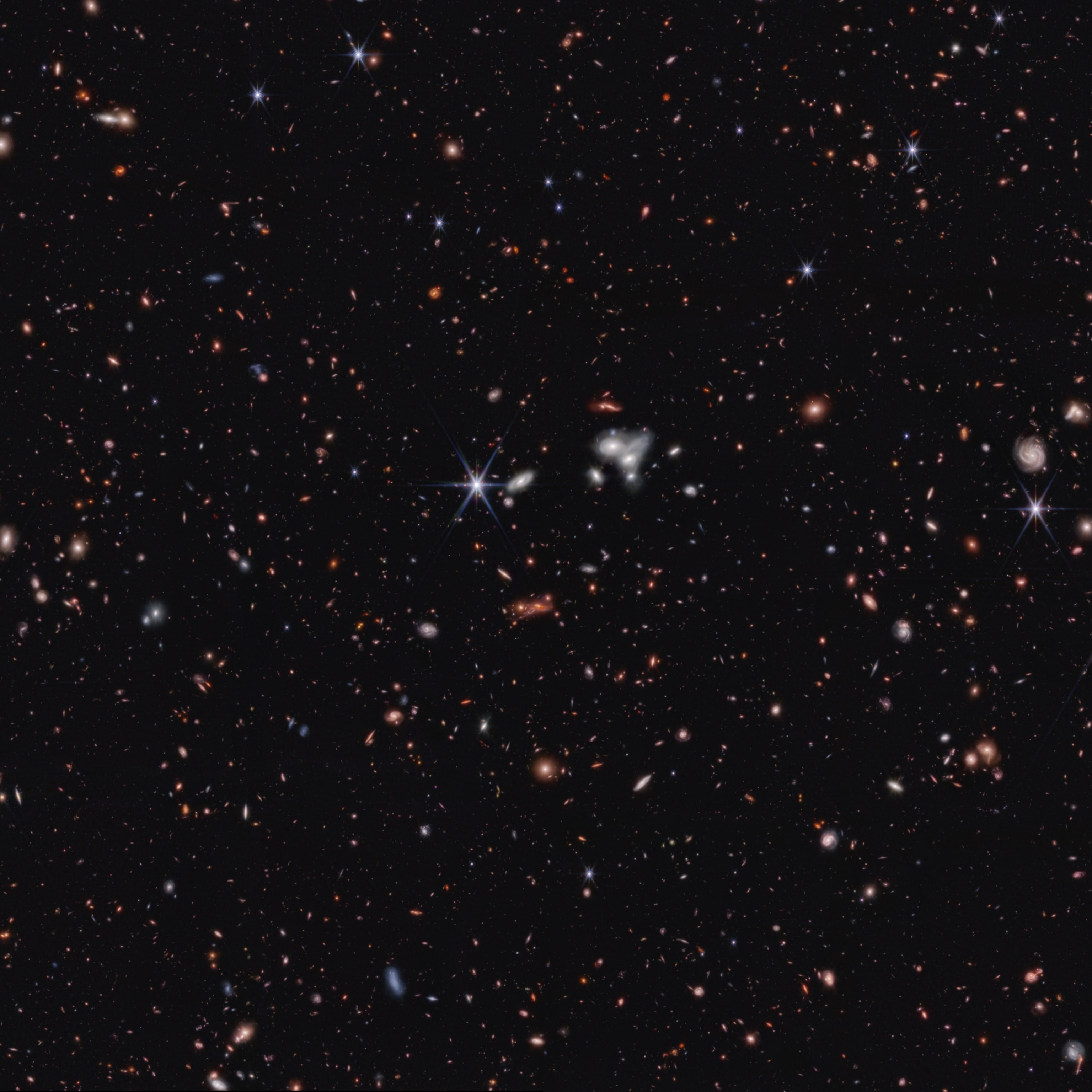
This supermassive black hole was formed when the universe was a toddler

This is what the first stars looked like as they were being born
Physicists were also able to use the detection to test Einstein's theory of relativity as never before. Relativity predicts that light and gravitational waves from the same event should travel through space the same way. Other theories of gravity, however, predict that the two should arrive at Earth at markedly different times. In the actual event, the light and gravitational waves arrived within seconds of each other—which means that gravitational waves and light react to obstacles in almost exactly the same way, within one part in a million billion .
Gravitational waves also help clarify other aspects of our universe's foundation. For instance, the Hubble Constant, a measure of how quickly the universe is expanding, has been tricky to pin down. Measurements of the early universe's afterglow yield one number, but estimates made using much younger stars yield another number. Is the discrepancy just a sampling issue or error ? Or has the Hubble constant changed over time— suggesting the presence of new, bizarre particles and forces ?
By acting as “standard sirens,” gravitational wave detections provide an independent way to calculate the Hubble constant , making them the ultimate referee in this cosmic debate.
Can people feel gravitational waves?
The effect that gravitational waves have on Earth is thousands of times smaller than the width of a proton, one of the particles that makes up an atom's nucleus. That said, gravitational waves weaken the farther they travel, much like ripples on a pond. The closer you are to two merging black holes, the more you'd be stretched and strained.
But as trippy as it sounds, a gravitational wave stretches and compresses a given object as a percentage of the object's size. If Earth were as far from the black-hole merger that yielded LIGO's first detection as it is from the sun, gravitational waves would have stretched the planet by more than three feet. But peoples' bodies would be strained by just a millionth of a meter, far less than the compression you feel when you jump up and land on the ground.
Gravitational waves' proportional nature is why LIGO and other observatories have such large arms. The bigger the observatory, the bigger—and more detectable—the changes from a wave become.
Where are gravitational-wave observatories?
In 2017, the European observatory Virgo opened outside of Pisa, Italy, joining LIGO and Germany's GEO600 detector. And more such facilities are coming online: Japan's KAGRA detector, the first built underground, should be opening soon , and India is making plans to build its own detector.

This artist's concept shows ESA's LISA Pathfinder spacecraft, which launched on Dec. 3, 2015 on a mission to detect gravitational waves.
In addition, there are plans to launch large, space-based observatories. The European Space Agency plans to put a detector called LISA into orbit around the sun in the 2030s. In 2015, the ESA launched the LISA Pathfinder spacecraft to test the necessary technology. Chinese researchers have proposed a similar space-based detector called TianQin .
Meanwhile, astronomers keep monitoring arrays of pulsars to track very low-frequency gravitational waves. The thinking is that as a wave sweeps through, it would temporarily alter the timing of each pulsar's rotation.
In a few decades' time, we'll be able to hear the universe as never before, from the deep rumble of merging supermassive black holes to the zippy chirps of colliding neutron stars. The universe is full of light; now we know it's also full of music.
Related Topics
- BLACK HOLES

What is causing these massive, mysterious explosions in space?

What’s out there? Why humanity keeps pushing the cosmic frontier.

What is the multiverse—and is there any evidence it really exists?
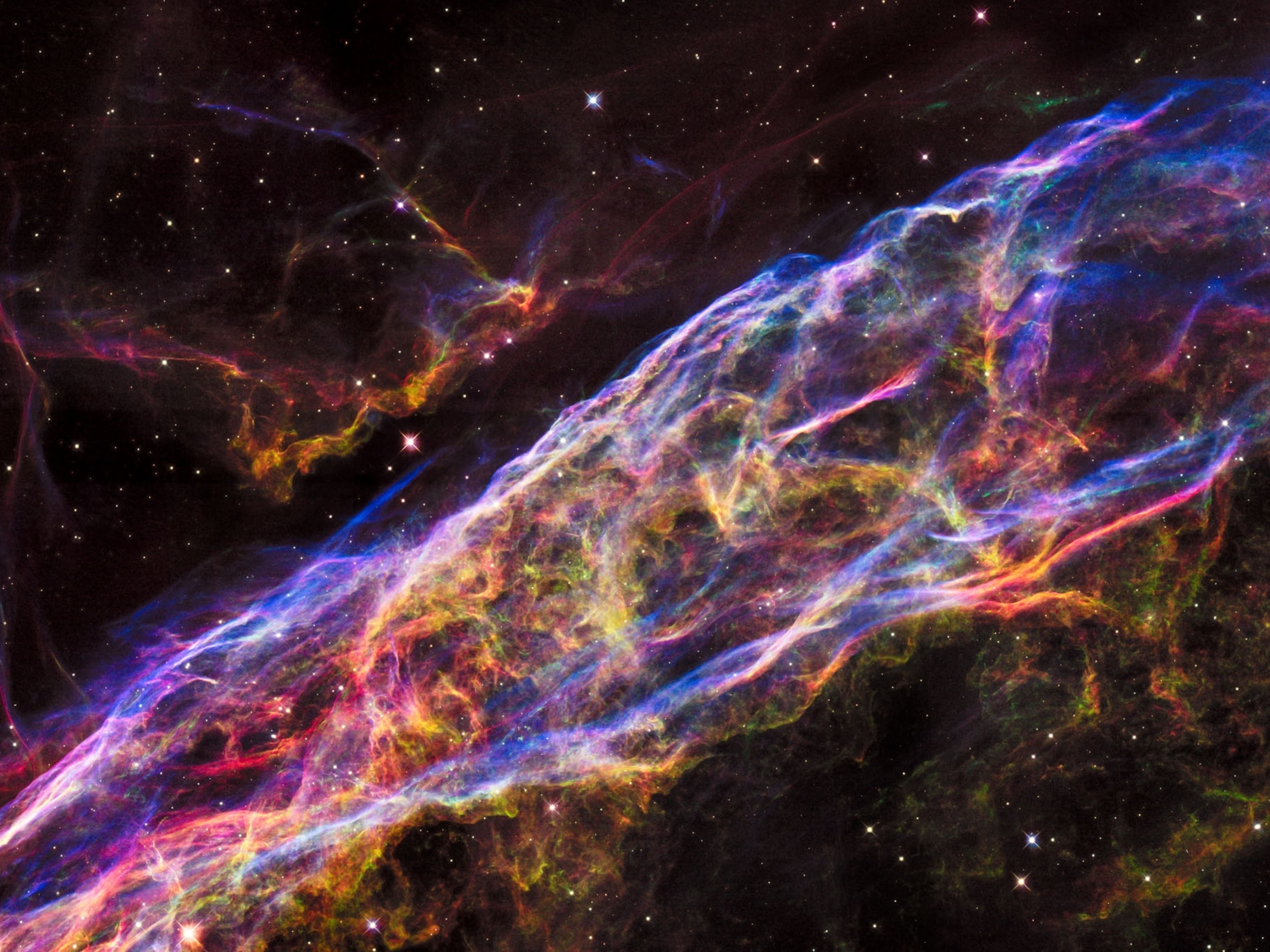
After 30 years, Hubble is still revealing new mysteries of the universe

Meet the Woman Who Wants to Solve the Universe’s Mysteries
- Environment
History & Culture
- History & Culture
- Mind, Body, Wonder
- Paid Content
- Terms of Use
- Privacy Policy
- Your US State Privacy Rights
- Children's Online Privacy Policy
- Interest-Based Ads
- About Nielsen Measurement
- Do Not Sell or Share My Personal Information
- Nat Geo Home
- Attend a Live Event
- Book a Trip
- Inspire Your Kids
- Shop Nat Geo
- Visit the D.C. Museum
- Learn About Our Impact
- Support Our Mission
- Advertise With Us
- Customer Service
- Renew Subscription
- Manage Your Subscription
- Work at Nat Geo
- Sign Up for Our Newsletters
- Contribute to Protect the Planet
Copyright © 1996-2015 National Geographic Society Copyright © 2015-2024 National Geographic Partners, LLC. All rights reserved
Thank you for visiting nature.com. You are using a browser version with limited support for CSS. To obtain the best experience, we recommend you use a more up to date browser (or turn off compatibility mode in Internet Explorer). In the meantime, to ensure continued support, we are displaying the site without styles and JavaScript.
- View all journals
- Explore content
- About the journal
- Publish with us
- Sign up for alerts
- Published: 09 February 2016
Gravitational waves: 6 cosmic questions they can tackle
- Davide Castelvecchi
Nature ( 2016 ) Cite this article
2640 Accesses
986 Altmetric
Metrics details
- Astronomical instrumentation
- Astronomy and astrophysics
This article has been updated
The discovery of ripples in space-time has vindicated Einstein — but it can also do so much more.
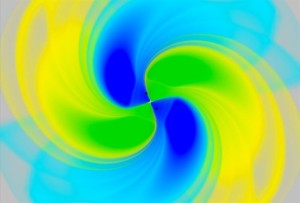
The first direct detection of gravitational waves was announced on 11 February by the Advanced Laser Interferometer Gravitational-Wave Observatory (LIGO). Using LIGO's twin giant detectors — one in Livingston, Louisiana, and the other in Hanford, Washington — researchers measured ripples in space-time produced by a collision between two black holes.

The announcement vindicates Albert Einstein’s prediction of gravitational waves, which he made almost exactly 100 years ago 1 as part of his general theory of relativity — but it also has much further significance. As vibrations in the fabric of space-time, gravitational waves are often compared to sound, and have even been converted into sound snippets . In effect, gravitational-wave telescopes allow scientists to ‘hear’ phenomena at the same time as light-based telescopes ‘see’ them. (Already, members of LIGO and its smaller counterpart Virgo in Pisa, Italy, have set up a system for alerting communities working on other types of telescope.)
When LIGO fought to get US government funding in the early 1990s, its major opponents at congressional hearings were astronomers 2 . “The general view was that LIGO didn’t have much to do with astronomy,” says Clifford Will, a general-relativity theorist at the University of Florida in Gainesville and an early LIGO supporter. But things have changed now, he says.
Welcome to the field of gravitational-wave astronomy 3 : we take a look at the questions and phenomena that it can explore.
Do black holes actually exist?
One of the important scientific consequences of LIGO’s detection of a black-hole merger is, quite simply, that it confirms that black holes really do exist — at least as the perfectly round objects made of pure, empty, warped space-time that are predicted by general relativity.
Astronomers had plenty of circumstantial evidence for black holes, but until now, that had come from observations of the stars and super-heated gas that orbit black holes, not of black holes themselves.
“The scientific community, including myself, has become very blasé about black holes. We have taken them for granted,” Frans Pretorius, a specialist in general-relativity simulations at Princeton University in New Jersey, told Nature before the LIGO announcement . “But if you think of what an astonishing prediction it is, we really need astonishing evidence.”
LIGO’s signal has provided that evidence — and also confirms that mergers between two black holes proceed as predicted. A merger occurs when two black holes start to spiral towards each other, radiating energy as gravitational waves. LIGO detected the characteristic sound of these waves, called a chirp, which allowed scientists to measure the masses of the two objects involved in the event the observatory spotted: one about 36 times the mass of the Sun, and the other 29 solar masses.
Next, the black holes fuse. “It’s as if you get two soap bubbles so close that they form one bubble. Initially, the bigger bubble is deformed,” says Thibault Damour, a gravity theorist at the Institute of Advanced Scientific Studies near Paris. The resulting single black hole will settle into a perfectly spherical shape, but first, as LIGO saw, it radiates gravitational waves in a pattern called a ringdown.
Do gravitational waves travel at the speed of light?
When scientists start to compare observations from LIGO with those from other types of telescope, one of the first things that they will check is whether the signals arrive at the same time. Physicists hypothesize that gravity is transmitted by particles called gravitons, the gravitational analogue of photons. If, like photons, these particles have no mass, then gravitational waves would travel at the speed of light, matching the prediction of the speed of gravitational waves in classical general relativity. (Their speed can be affected by the accelerating expansion of the Universe, but that should manifest only over distances much greater than LIGO can probe 4 ).
But it is possible that gravitons have a slight mass , which would mean that gravitational waves would travel at less than the speed of light. So if, say, LIGO and Virgo were to detect gravitational waves from a cosmic event, and find that the waves took slightly longer to arrive at Earth than the associated burst of γ-rays detected by a more conventional telescope, that could have momentous consequences for fundamental physics.
Is space-time made of cosmic strings?
An even weirder discovery would occur if bursts of gravitational waves were detected coming from ‘ cosmic strings ’. These hypothetical defects in the curvature of space-time, which may or may not be related to string theory, would be infinitesimally thin but would stretch across cosmic distances. Researchers have predicted that cosmic strings, if they exist, might occasionally develop kinks; if a string snapped, it would suddenly release a burst of gravitational waves, which detectors such as LIGO and Virgo could measure.
Are neutron stars rugged?
Neutron stars are the remnants of bigger stars that collapsed under their own weight, becoming so dense that they pushed their constituent electrons and protons to fuse into neutrons . Their extreme physics is poorly understood, but gravitational waves could provide unique insights. For example, the intense gravity at their surface tends to make neutron stars almost perfectly spherical. But some researchers have theorized that there could still be ‘mountains’ — at most a few millimetres high — that make these dense objects, themselves about 10 kilometres in diameter, slightly asymmetrical. Neutron stars usually spin very rapidly, so the asymmetric distribution of mass would deform space-time and produce a continuous gravitational-wave signal in the shape of a sine wave, which would radiate energy and slow down the star’s spin.

Pairs of neutron stars that orbit each other would also produce a continuous signal. Just like black holes, the stars would spiral into each other and eventually merge, sometimes producing an audible chirp. But their final instants would differ dramatically from those of black holes. “You have a zoo of possibilities, depending on masses and how much pressure neutron-dense matter can exert,” says Pretorius. For example, the resulting merged star could be a huge neutron star, or it could immediately collapse and turn into a black hole.
What makes stars explode?
Black holes and neutron stars form when massive stars stop shining and collapse in on themselves. Astrophysicists think that this process is what powers a common type of supernova explosion , known as Type II. Simulations of such supernovae have not yet clearly explained what ignites them, but listening to the gravitational-wave bursts that real supernova are expected to produce could help to provide an answer. Depending on what the bursts’ waveforms look like, how loud the bursts are, how frequent they are and how they correlate with the supernovae as seen with electromagnetic telescopes, the data could help to validate or discard various, existing models.

How fast is the Universe expanding?
The expansion of the Universe means that distant objects that are receding from our Galaxy look redder than they really are, because the light that they emit stretches as it travels. Cosmologists estimate the rate of the Universe’s expansion by comparing this redshift of galaxies with how far the galaxies are from us. But that distance is usually gauged from the brightness of ‘Type Ia’ supernovae — a technique that leaves large uncertainties.
If several gravitational-wave detectors across the world detect signals from the same neutron-star merger, together they will be able to provide an estimate of the absolute loudness of the signal, which will reveal how far away the merger occurred. They will also be able to estimate the direction it came from; astronomers could then deduce which galaxy hosted the merger. Comparing that galaxy’s redshift with the distance of the merger as measured by the loudness of the gravitational waves could provide an independent estimate of the rate of cosmic expansion, possibly more accurate than current methods.
Nereid journeys under Arctic ice
The submersible completed four dives in polar waters in July 2014. WOODS HOLE OCEANOGRAPHIC INSTITUTION
Change history
11 february 2016.
(11 February): Updated to include details of LIGO's announcement.
Einstein, A. Sitsber. K. Preuss. Aka. 1 , 688-696 (1916).
Google Scholar
Collins, H. Gravity’s Shadow (University of Chicago Press, 2004).
Sathyaprakash, B. S. & Schutz, B. F. Living Rev. Relativity http://dx.doi.org/10.12942/lrr-2009-2 (2009).
Ashtekar, A., Bonga, B. & Kesavan, A. Phys. Rev. Lett. 116 , 051101 (2016).
Article ADS Google Scholar
Download references
You can also search for this author in PubMed Google Scholar
Additional information
Tweet Facebook LinkedIn weibo
Related video
Merging black holes: Side view Bohn, Throwe, Hébert, Henriksson, Bunandar, Taylor, Scheel (http://www.black-holes.org/lensing)
Black hole merger A simulation of two black holes spiralling into each other, and the gravitational waves they would produce. S. Shapiro, R. Gold, V. Paschalidis, M. Ruiz, Z. Etienne & H. Pfeiffer. Movie: S. Shapiro, S. Connelly, A. Khan and L. Kong.
Electronic supplementary material
Cosmic strings
Related links
Related links in nature research.
Nature Special: General relativity at 100
Related external links
Rights and permissions.
Reprints and permissions
About this article
Cite this article.
Castelvecchi, D. Gravitational waves: 6 cosmic questions they can tackle. Nature (2016). https://doi.org/10.1038/nature.2016.19337
Download citation
Published : 09 February 2016
DOI : https://doi.org/10.1038/nature.2016.19337
Share this article
Anyone you share the following link with will be able to read this content:
Sorry, a shareable link is not currently available for this article.
Provided by the Springer Nature SharedIt content-sharing initiative
Quick links
- Explore articles by subject
- Guide to authors
- Editorial policies
Sign up for the Nature Briefing newsletter — what matters in science, free to your inbox daily.

IMAGES
VIDEO
COMMENTS
Creighton explains that in electromagnetism, when you shake an electron, it creates a change in the electric field that spreads out at the speed of light. Gravity works the same way. Shake a mass and the change in the gravitational field — the gravitational wave — propagates at that same speed. "So the fact that the speed of gravitational ...
Gravitational waves travel at the speed of light (186,000 miles per second). These waves squeeze and stretch anything in their path as they pass by. A gravitational wave is an invisible (yet incredibly fast) ripple in space. We've known about gravitational waves for a long time. More than 100 years ago, a great scientist named Albert Einstein ...
We have used binary pulsar data to constrain the speed of gravity to be equal to the speed of light to a precision of 99.8%, and to infer the existence of gravitational waves decades before LIGO ...
Gravitational waves are waves of the intensity of gravity that are generated by the accelerated masses of binary stars and other motions of gravitating masses, and propagate as waves outward from their source at the speed of light.They were first proposed by Oliver Heaviside in 1893 and then later by Henri Poincaré in 1905 as the gravitational equivalent of electromagnetic waves.
Approximate light signal travel times; Distance: Time: one foot: 1.0 ns: one metre: 3.3 ns: from geostationary orbit to Earth: 119 ms: the length of Earth's equator: 134 ms: from Moon to Earth: ... The speed of gravitational waves in the general theory of relativity is equal to the speed of light in a vacuum, c.
Gravitational waves travel at the speed of light (186,000 miles per second or 299,000 kilometers per second), squeezing and stretching anything in their path. In his theory of general relativity, Albert Einstein predicted the existence of gravitational waves. In 1916, his calculations showed that massive, accelerating objects would disrupt and ...
This dichotomy is repaired by Einstein's theory of gravitation, wherein accelerated masses also produce signals (gravitational waves) that travel only at the speed of light. And, just as electromagnetic waves can make their presence known by the pushing to and fro of electrically charged bodies, so too can gravitational waves be detected by ...
By comparing arrival times of the bursts of electromagnetic and gravitational waves with a precision of a few seconds, we could check for any difference in speed to the level of a few parts in 10 ...
These cosmic ripples would travel at the speed of light, carrying with them information about their origins, as well as clues to the nature of gravity itself. The strongest gravitational waves are produced by cataclysmic events such as colliding black holes, supernovae (massive stars exploding at the end of their lifetimes), and colliding ...
A beginner's guide to the BICEP2 discovery of primordial gravitational waves. ... gravitational waves can travel in empty space — and they do so at the speed of light.
In fact, gravitational waves travel at the speed of light: 186,000 miles per second! HOST PADI BOYD: If you want to study these fast-moving, space-rippling waves, you should probably aim your interest at cosmic objects whose gravity is really strong.
Gravitational waves, also known as gravitational radiation, were predicted by Albert Einstein as a consequence of his theory of general relativity. This theory describes gravity as distortions in the structure of spacetime created by matter and energy. Einstein realized those distortions would travel at the speed of light in the form of waves ...
These waves travel outward from the source at the speed of light and are literal ripples in the force of gravity. When a gravitational wave passes through you, you get stretched and squeezed as if ...
Gravitational waves are ripples in space-time, the fabric of the universe, that travel at the speed of light. Gravitational waves are created when objects speed up, slow down, or change direction. And just like light, they come in different wavelengths and frequencies.
As part of his theory of general relativity, Einstein predicted in 1916 that gravity propagates as a wave, mediated by a massless particle called a graviton that travels at the speed of light. These particles comprise gravitational waves in the same way that photons comprise light waves.
In space-time, these are the ripples we would call gravitational waves, and they travel at the speed of light. Where Do Gravitational Waves Come From? Gravitational waves are produced by masses moving through space-time in a special way. The simplest system that produces gravitational waves is two masses orbiting their common center of mass.
These gravitational waves travel at the speed of light and are completely invisible to a telescope, ... Image Caption: Masses of merging black holes and neutron stars detected with gravitational waves through 2020, organized from left to right based on when they were observed. The blue circles represent black holes and orange circles represent ...
Cornish's team of researchers combined the timings of the first three detections to narrow down the speed of the waves to between 55 and 142 percent of c. If enough detectors stay in top working order, this method could be used to calculate the figure to within just 1 percent of c by measuring just another five gravitational waves.
"In this case, the 'audio' of the soundtrack comes from the [gravitational wave] chirp of the neutron stars as they are inspiraling and colliding; the video is the light that we saw."
The speed of light in vacuum, commonly denoted c, is a universal physical constant that is exactly equal to 299,792,458 metres per second (approximately 300,000 kilometres per second; 186,000 miles per second; 671 million miles per hour). According to the special theory of relativity, c is the upper limit for the speed at which conventional matter or energy (and thus any signal carrying ...
Relativity predicts that light and gravitational waves from the same event should travel through space the same way. Other theories of gravity, however, predict that the two should arrive at Earth ...
In a nutshell, changes to the gravitational field propagate at the speed of light. Yet, the force between the orbiting objects is directed at the current position, not the position you see it at due to propagation delay (the light from it travels at the same speed as gravity).
LIGO and Virgo observations have experimentally confirmed the existence of gravitational waves. According to the Einstein's general relativity, gravitational waves have two degrees of polarization and, as a result, they travel at the speed of light. This is because, according to the field theory, the wave equation of massless spin-2 particles ...
But it is possible that gravitons have a slight mass, which would mean that gravitational waves would travel at less than the speed of light. So if, say, LIGO and Virgo were to detect ...
Famously, the speed that radially moving light travels falls to zero at the event horizon. So the answer to your first question is that yes gravity does slow the light reaching us from the Sun. To be more precise about this, we can measure the Schwarzschild radius r r by measuring the circumference of a circular orbit round the Sun and dividing ...
Image credit: Sergiu Bacioiu from Romania, under c.c.-2.0 generic. The speed of those ripples is determined the same way the speed of anything is determined in relativity: by their energy and ...
The results were definitive: they absolutely ruled out an infinite speed for the propagation of gravitational effects. Through these observations alone, scientists determined that the speed of ...